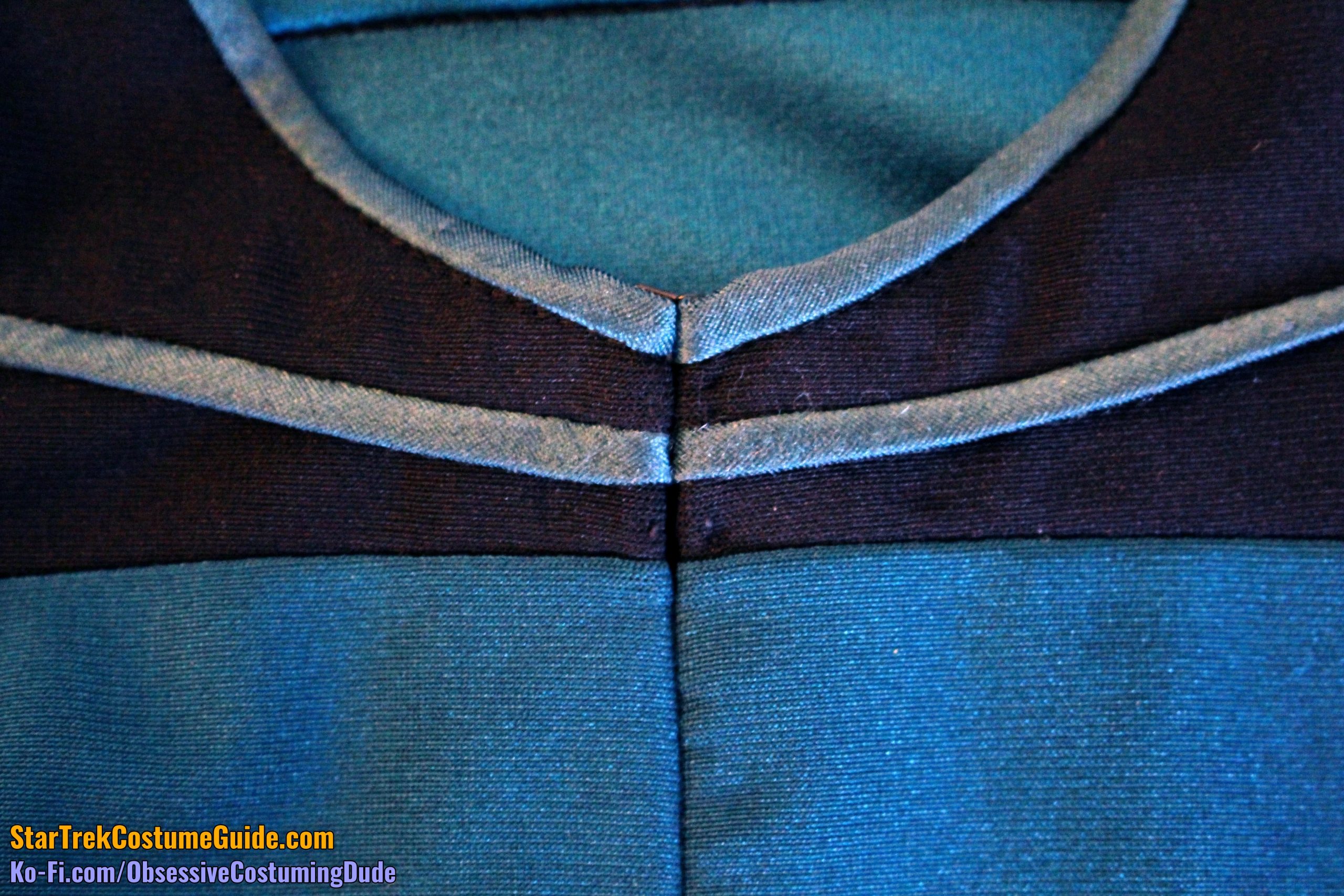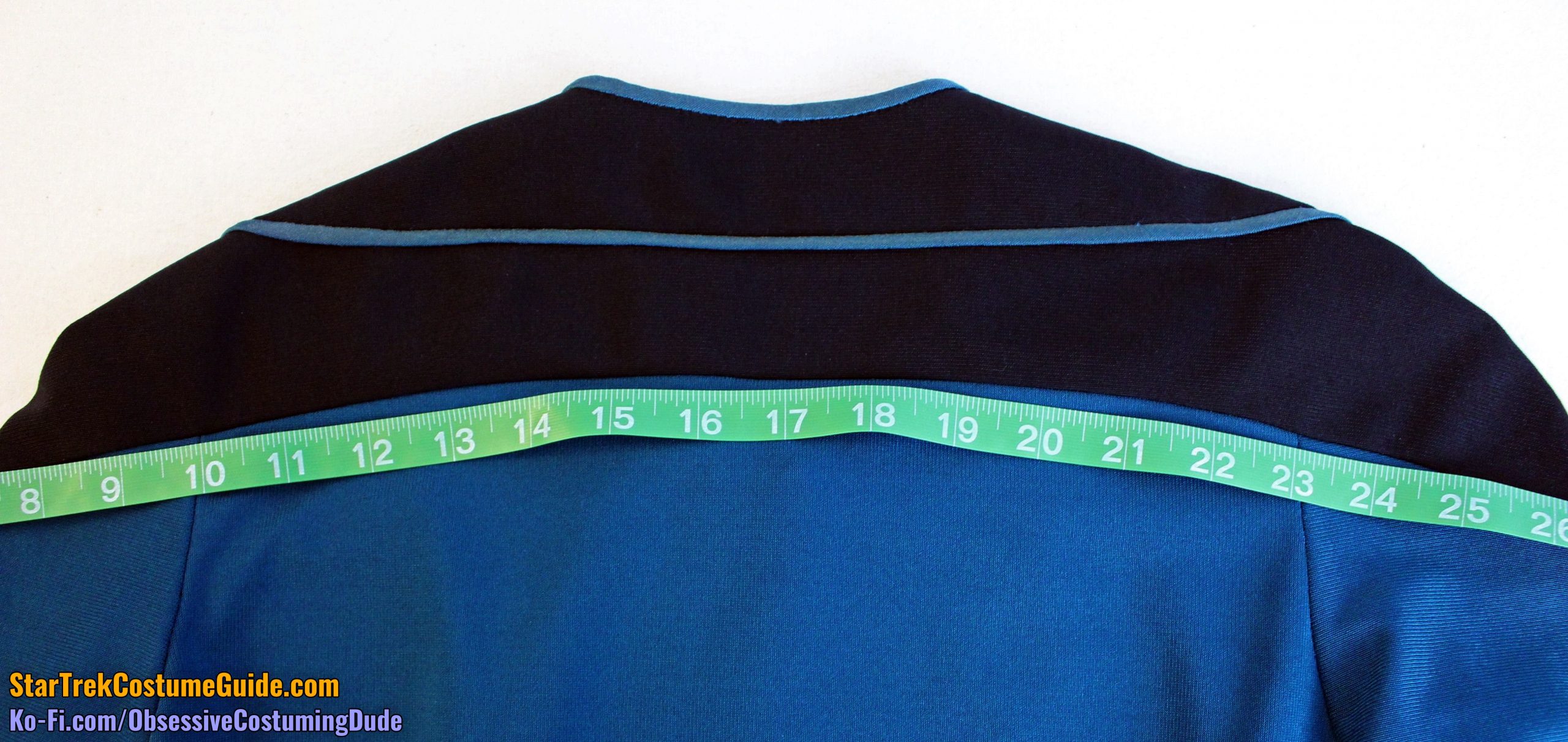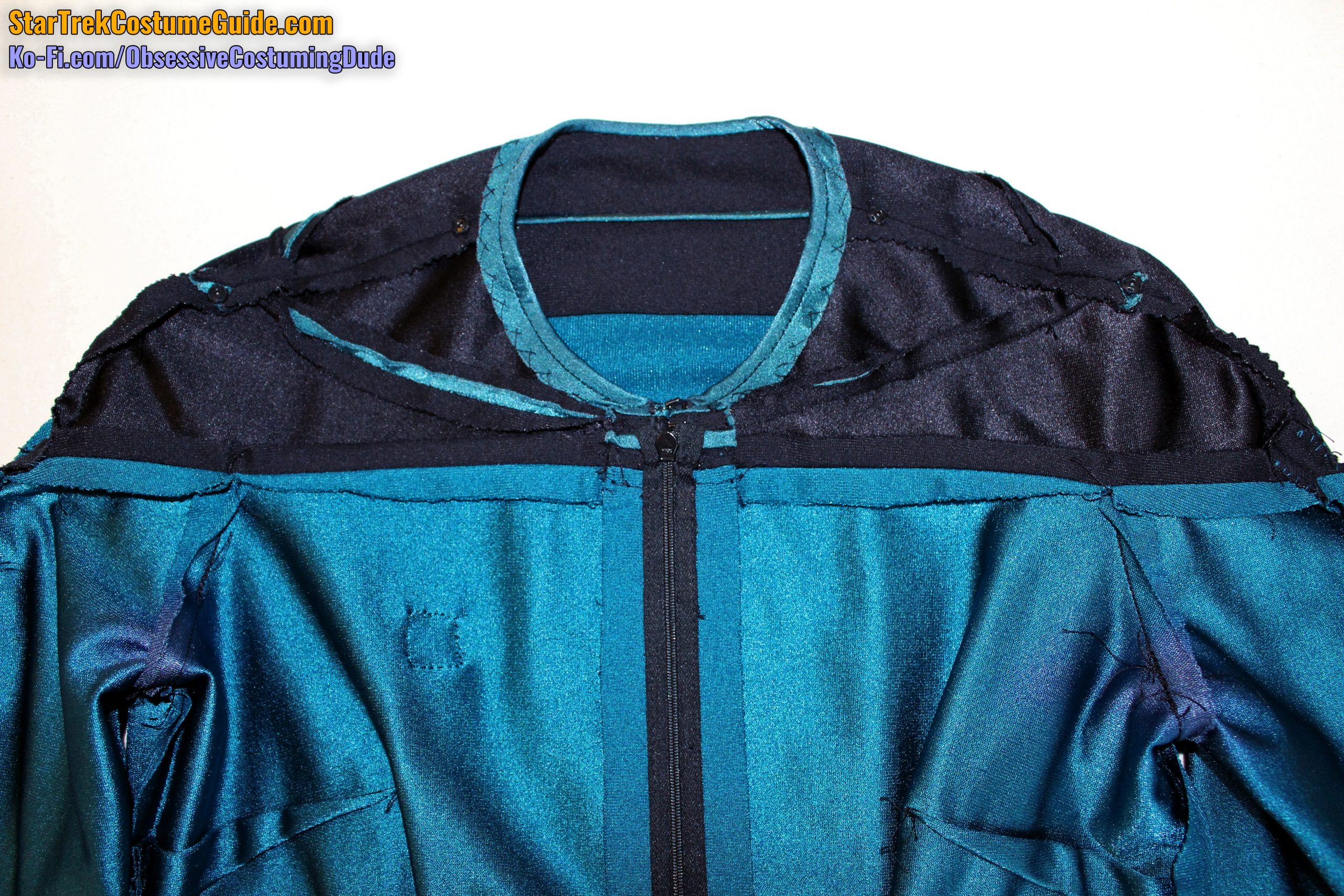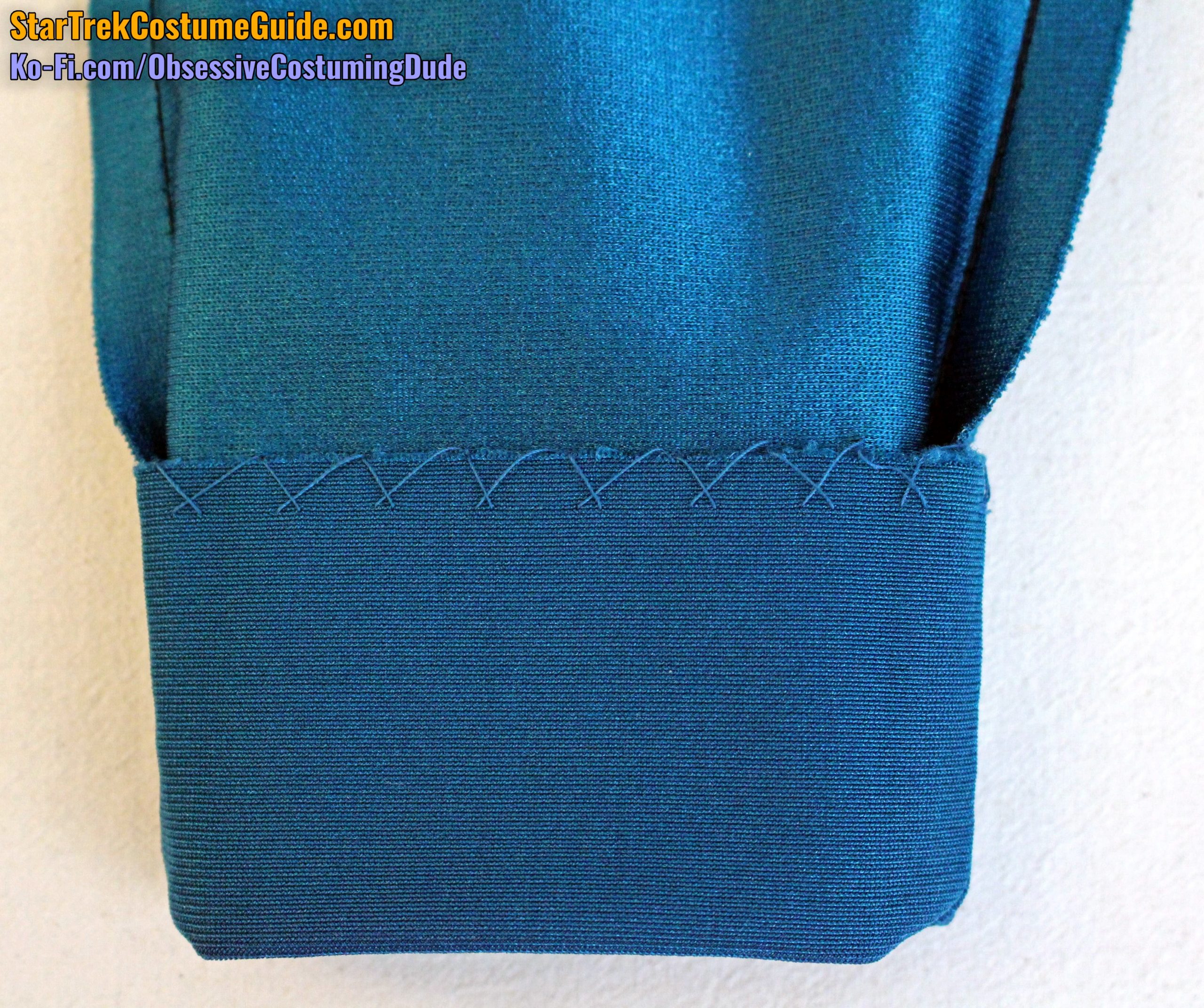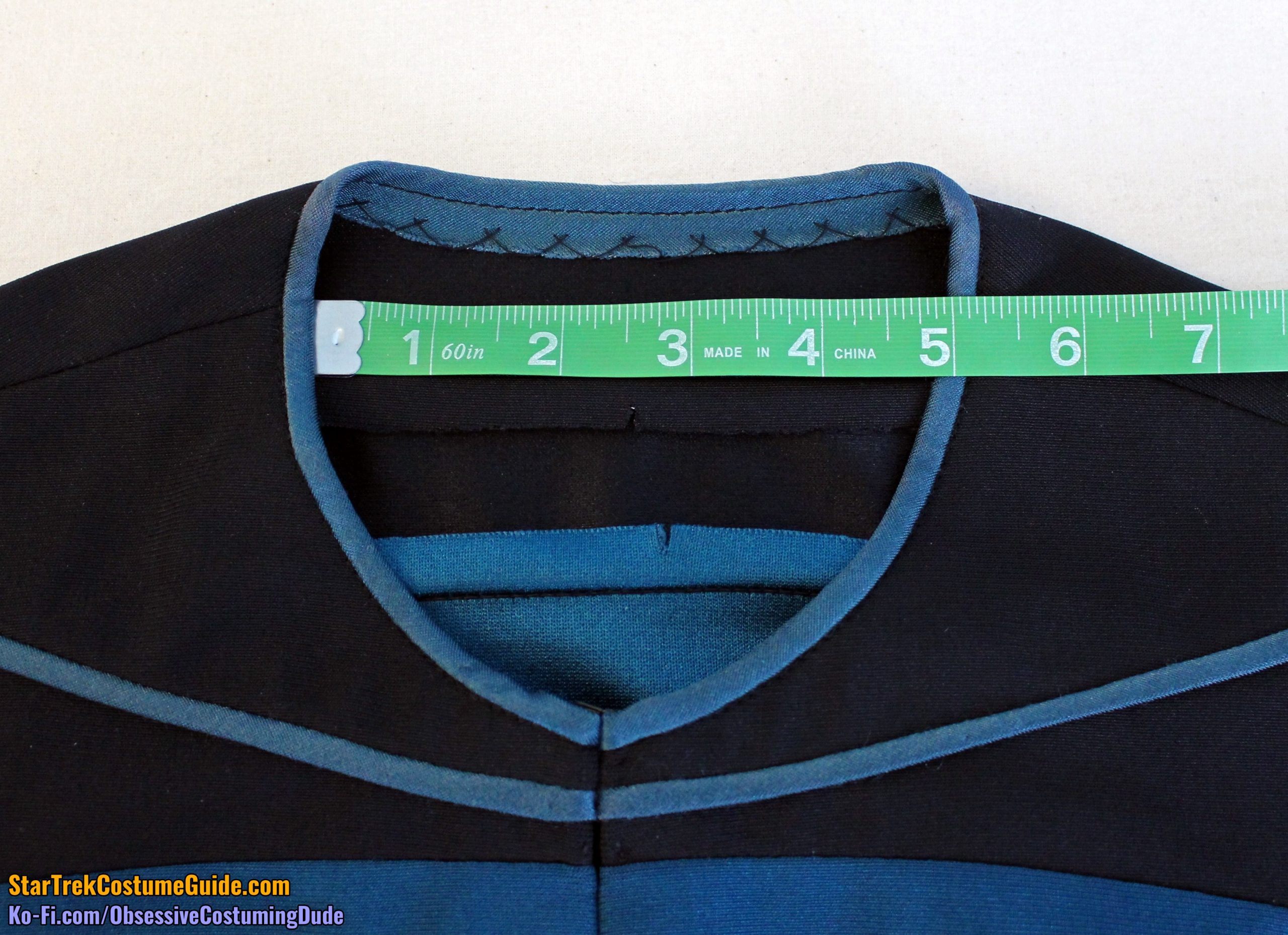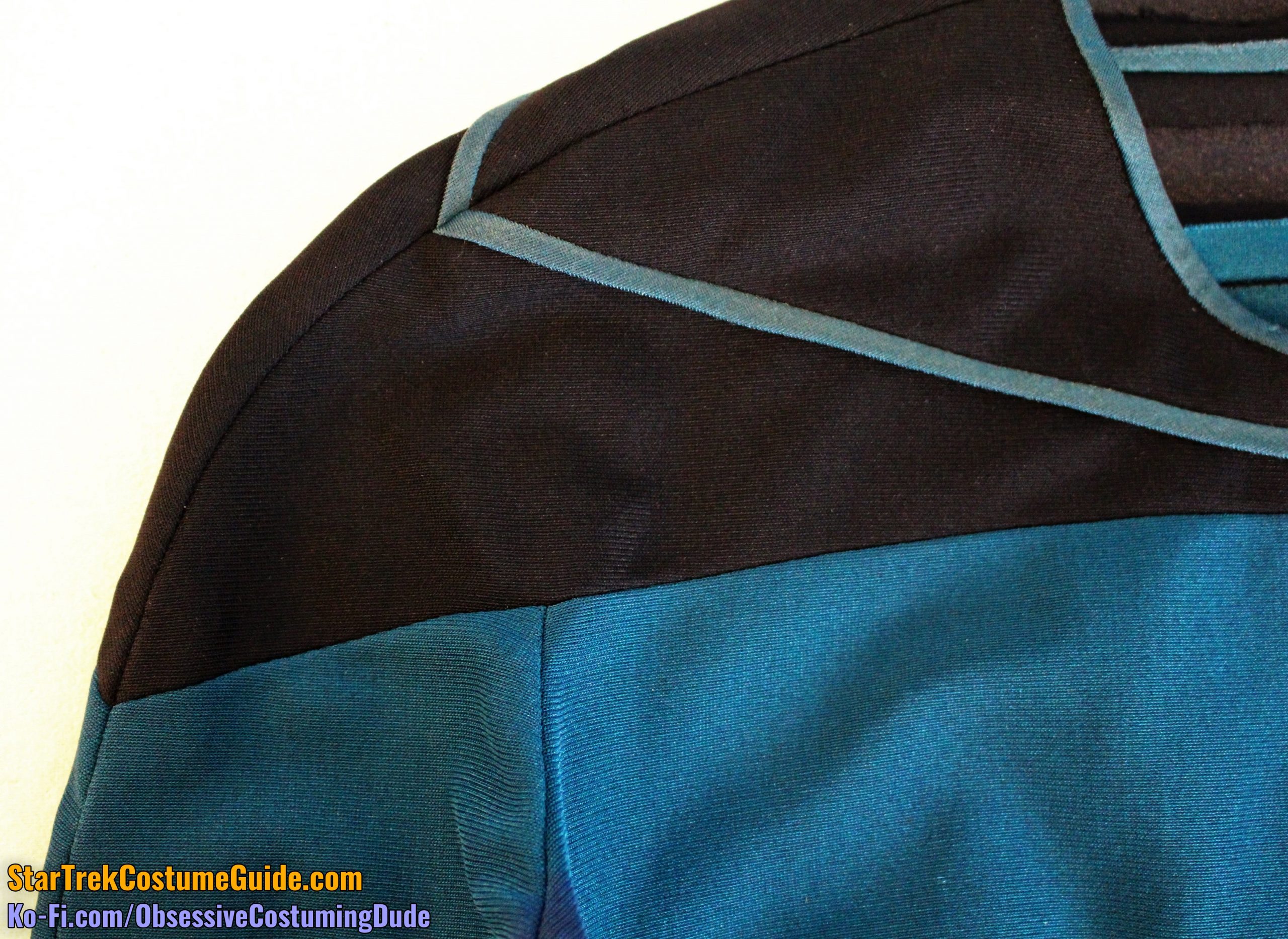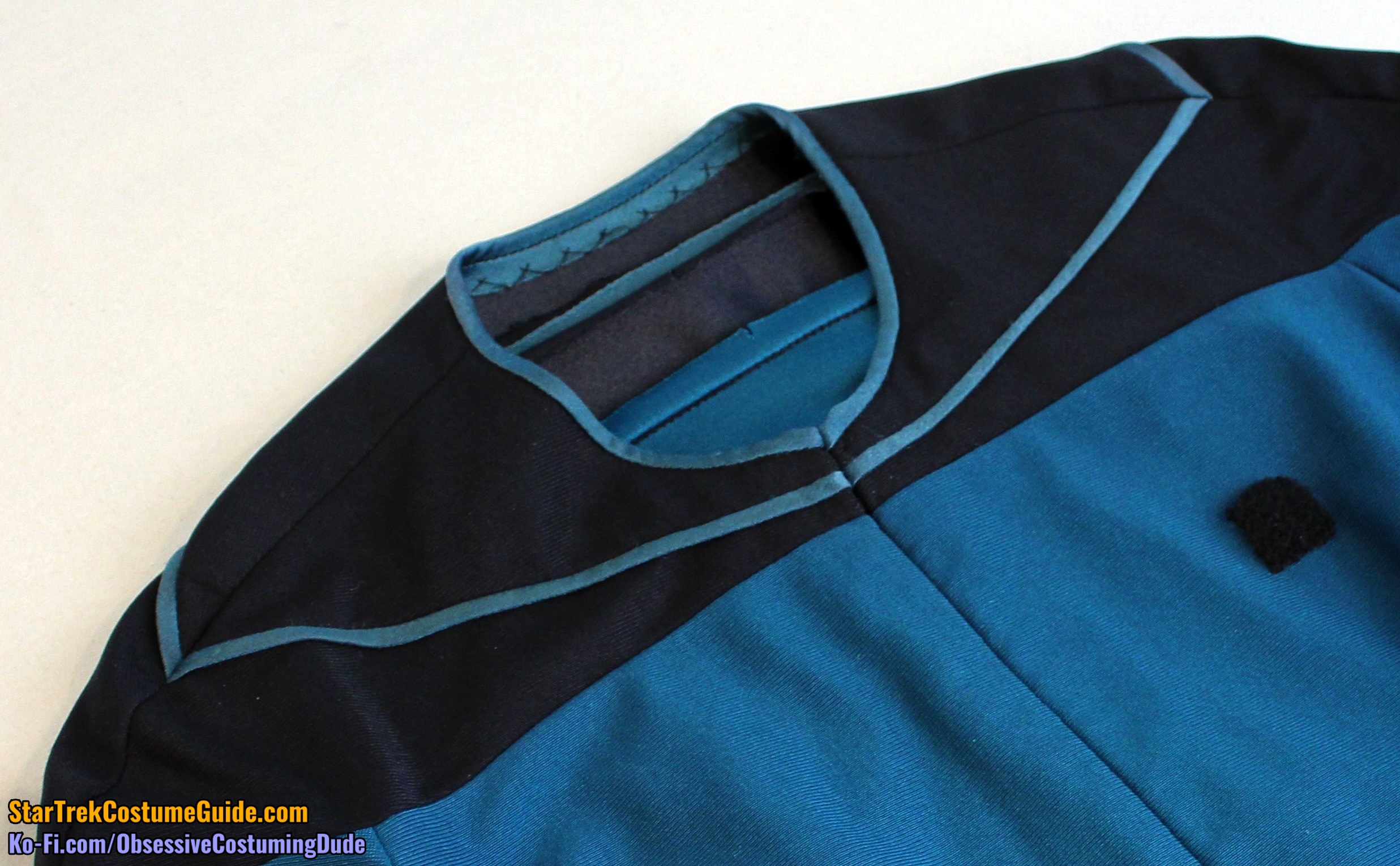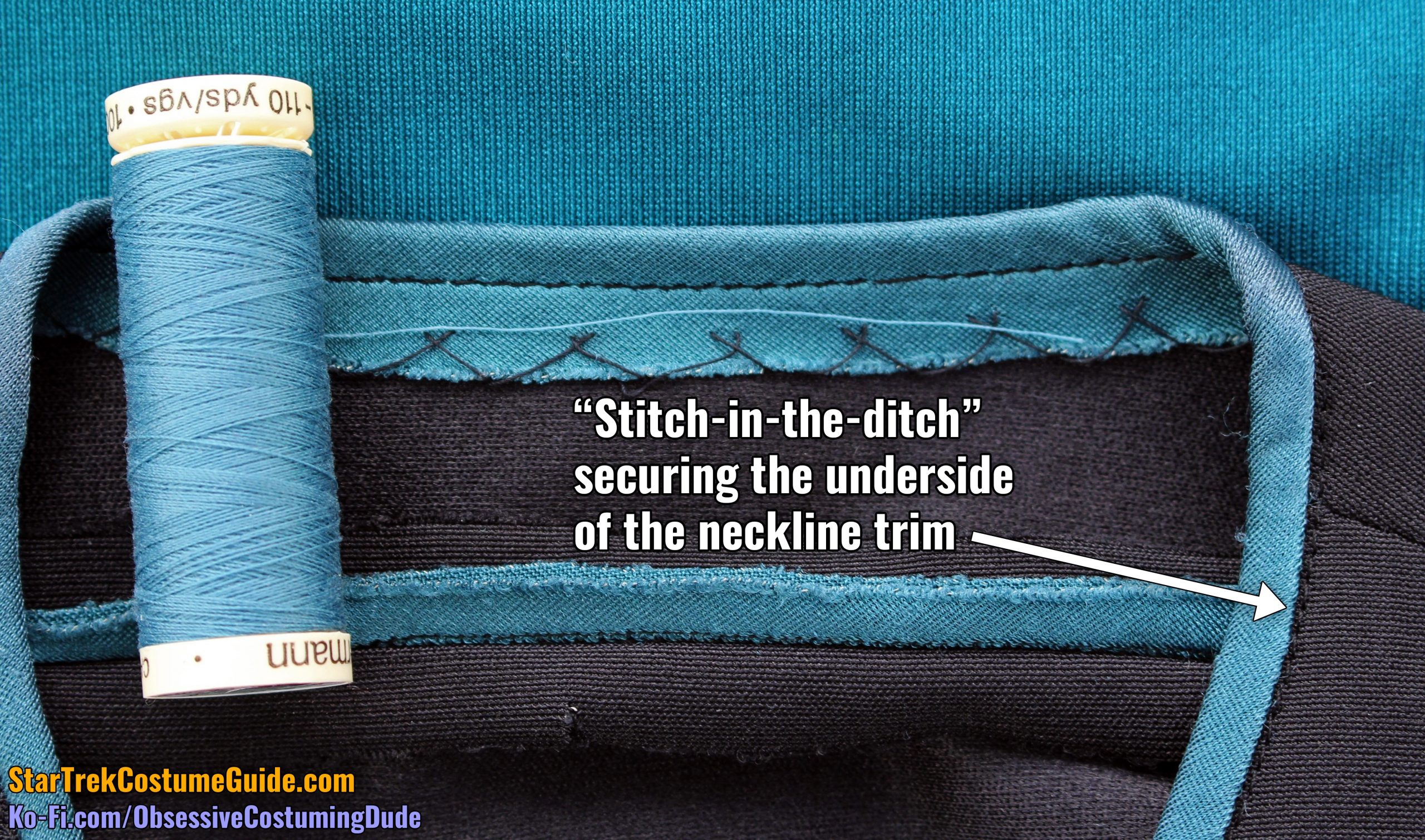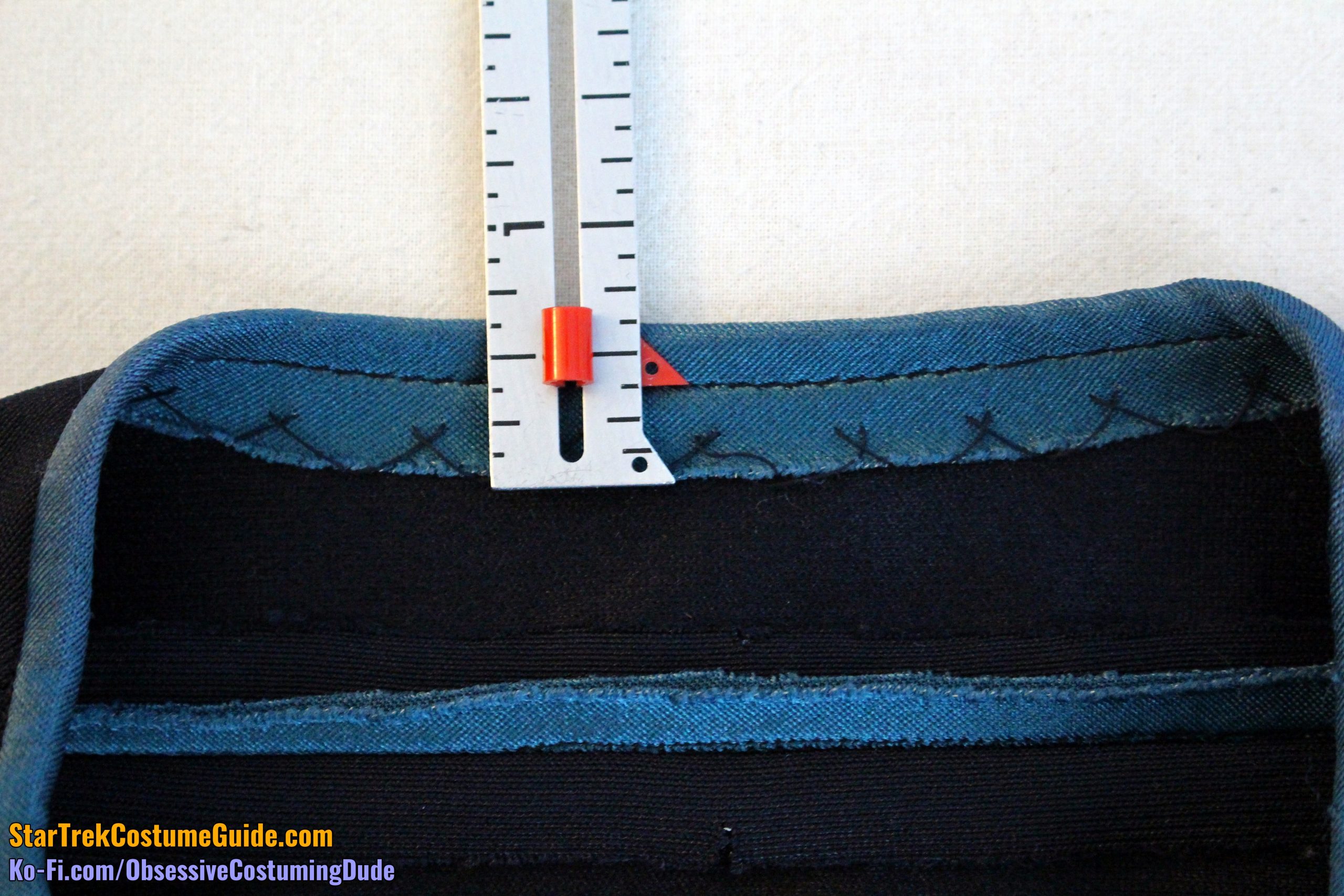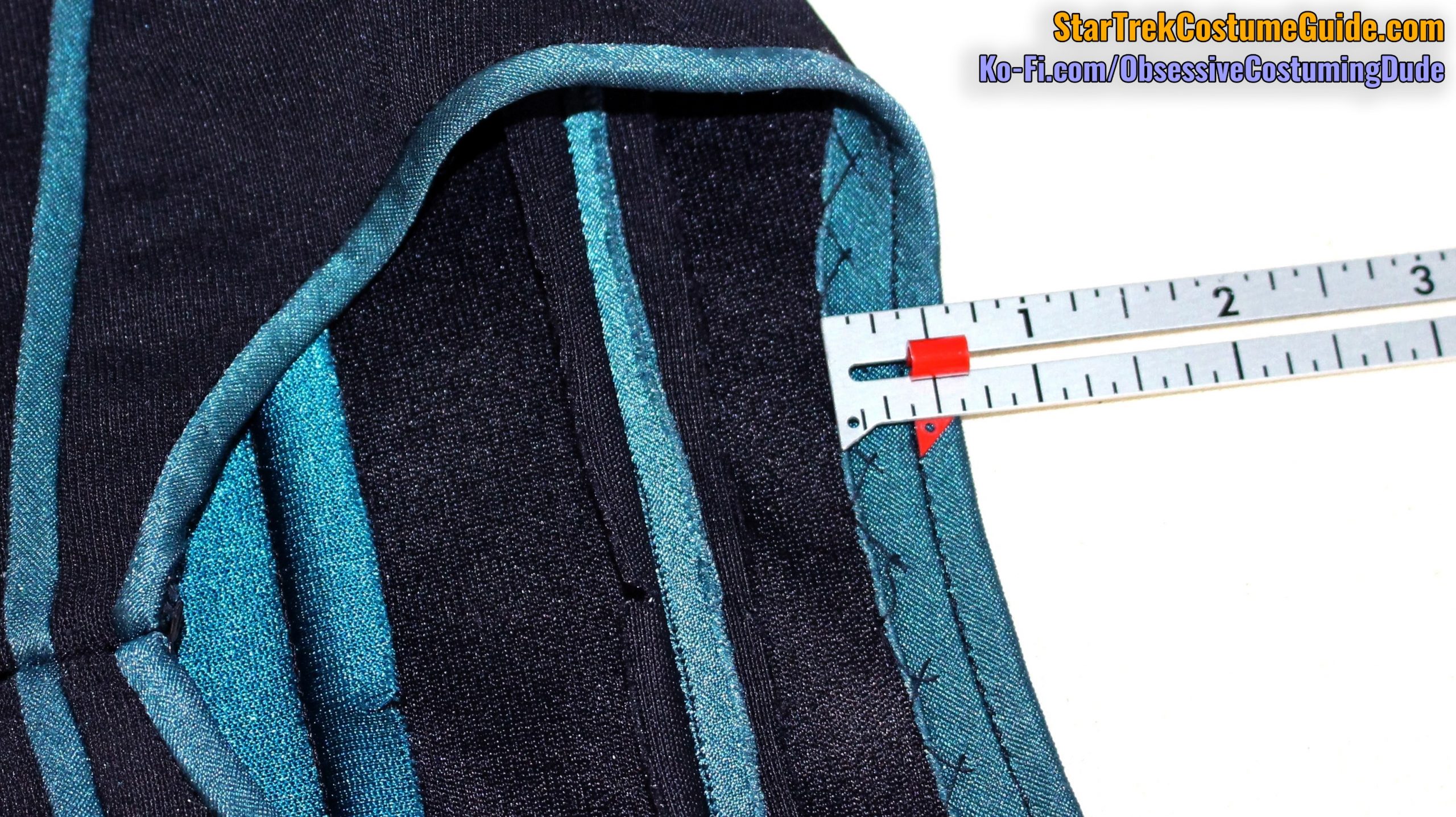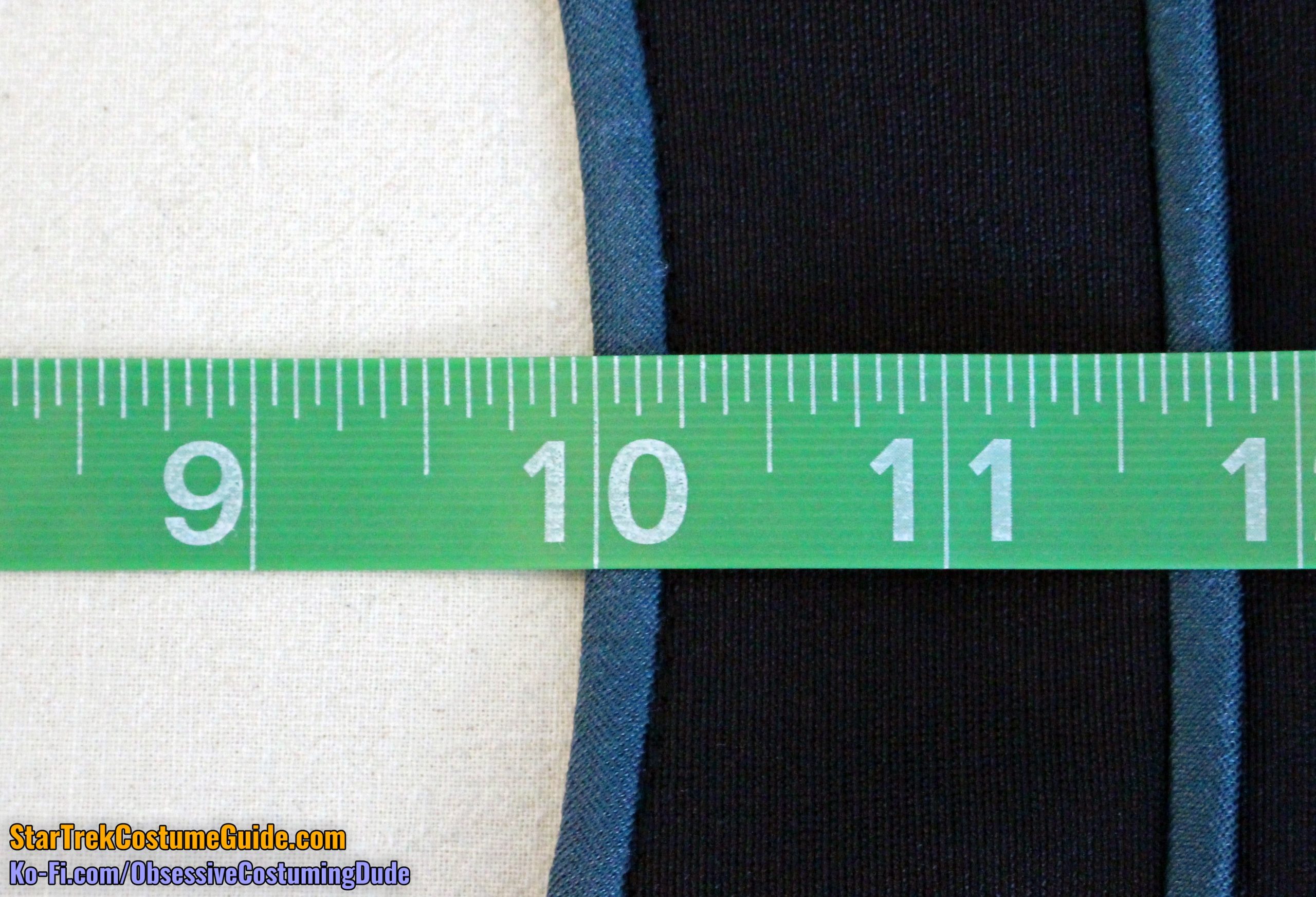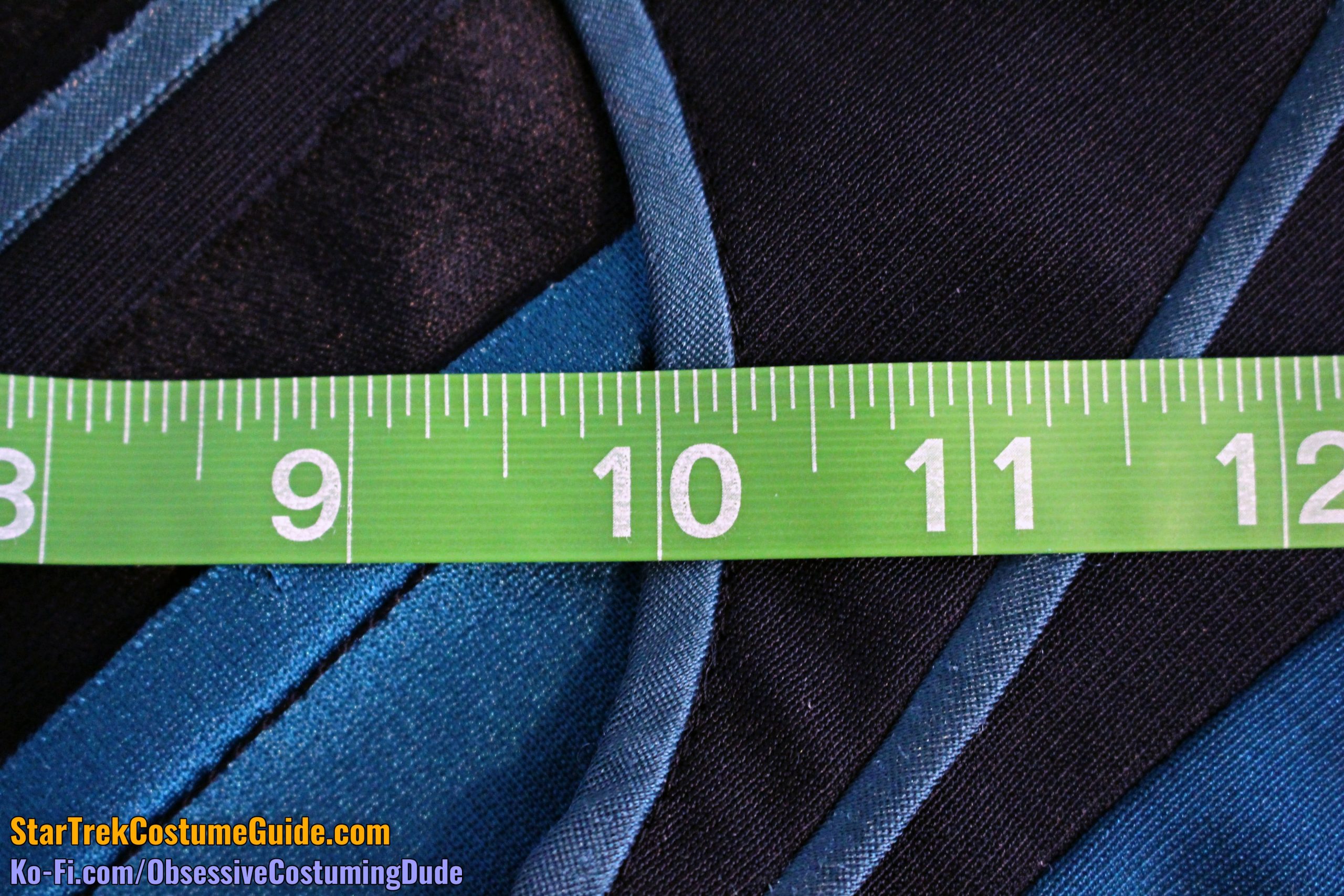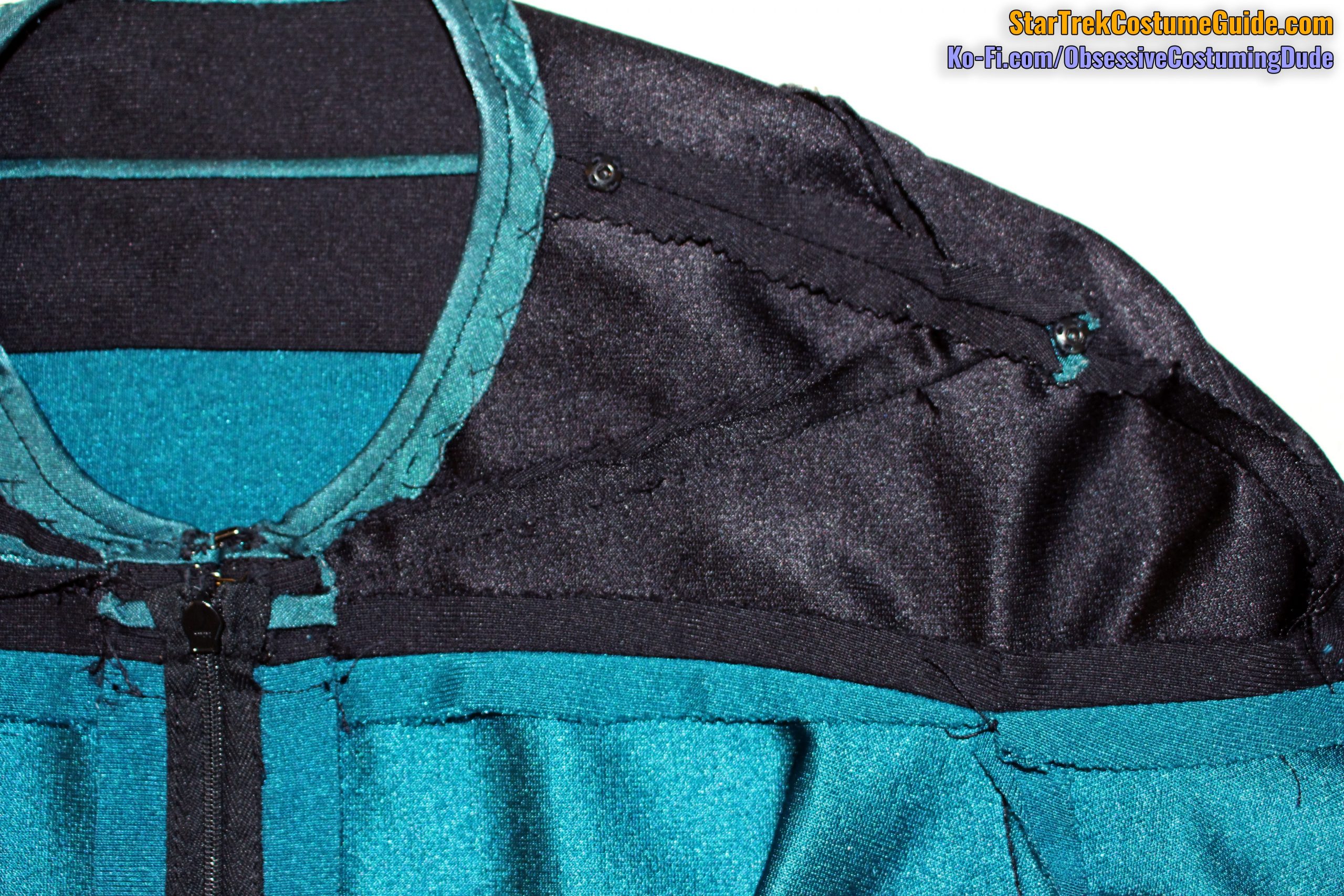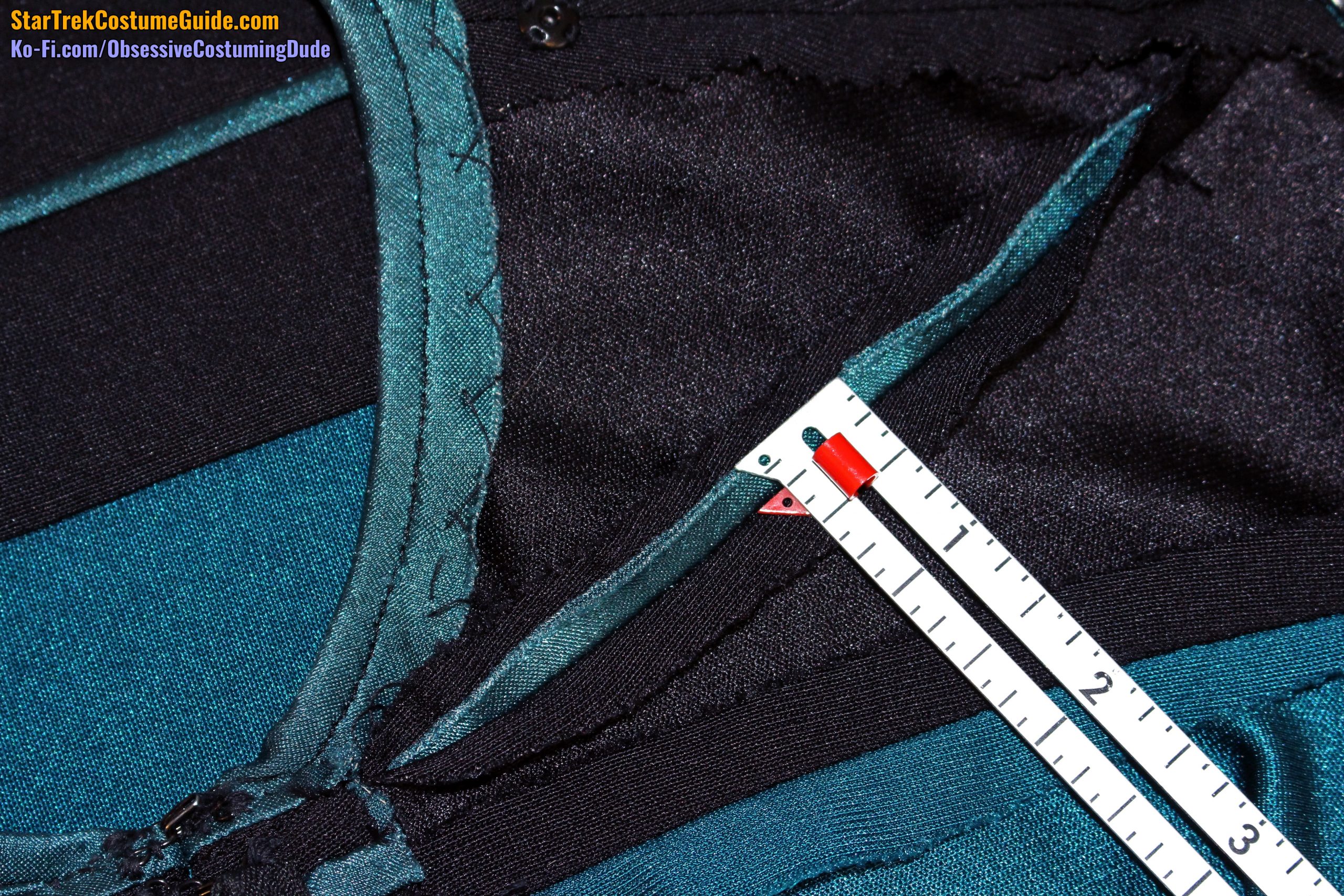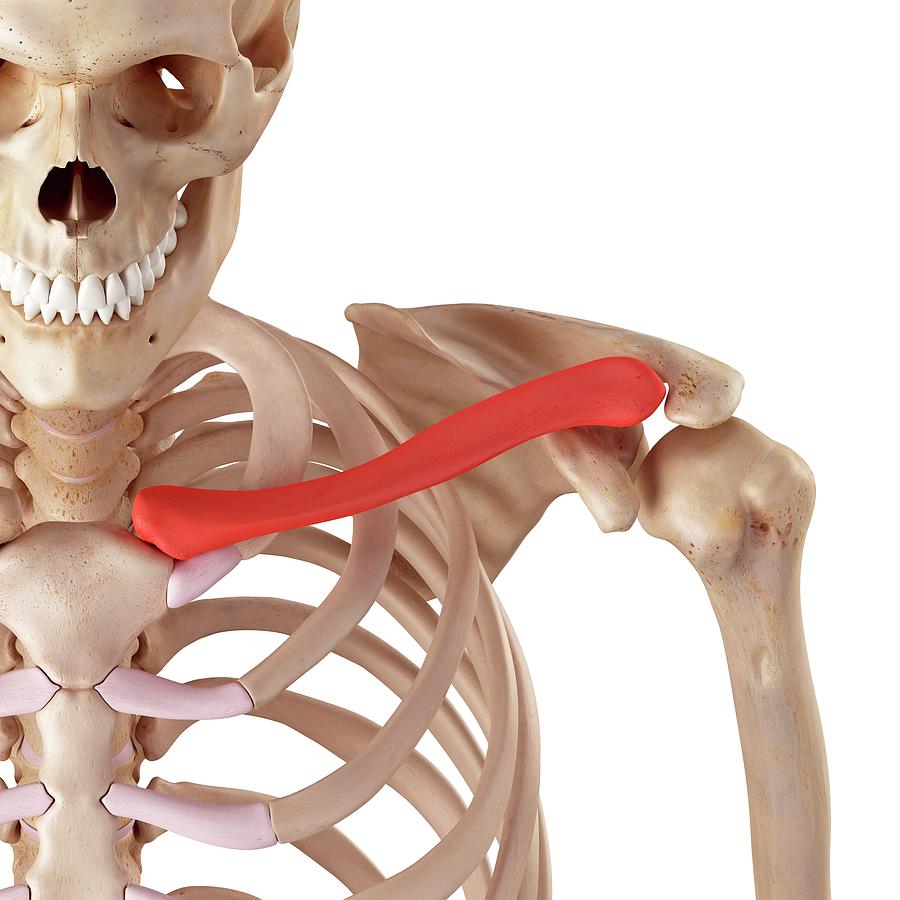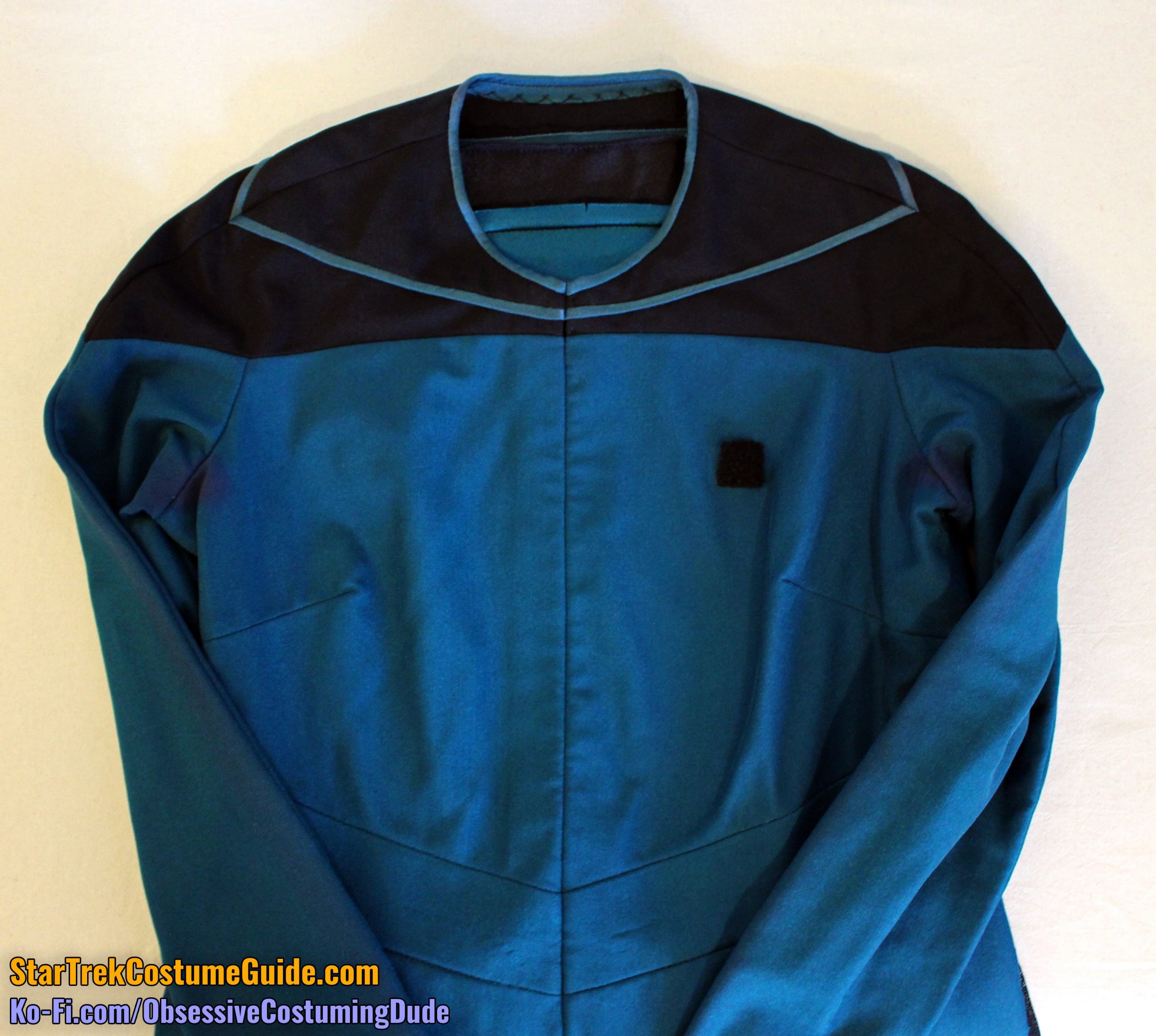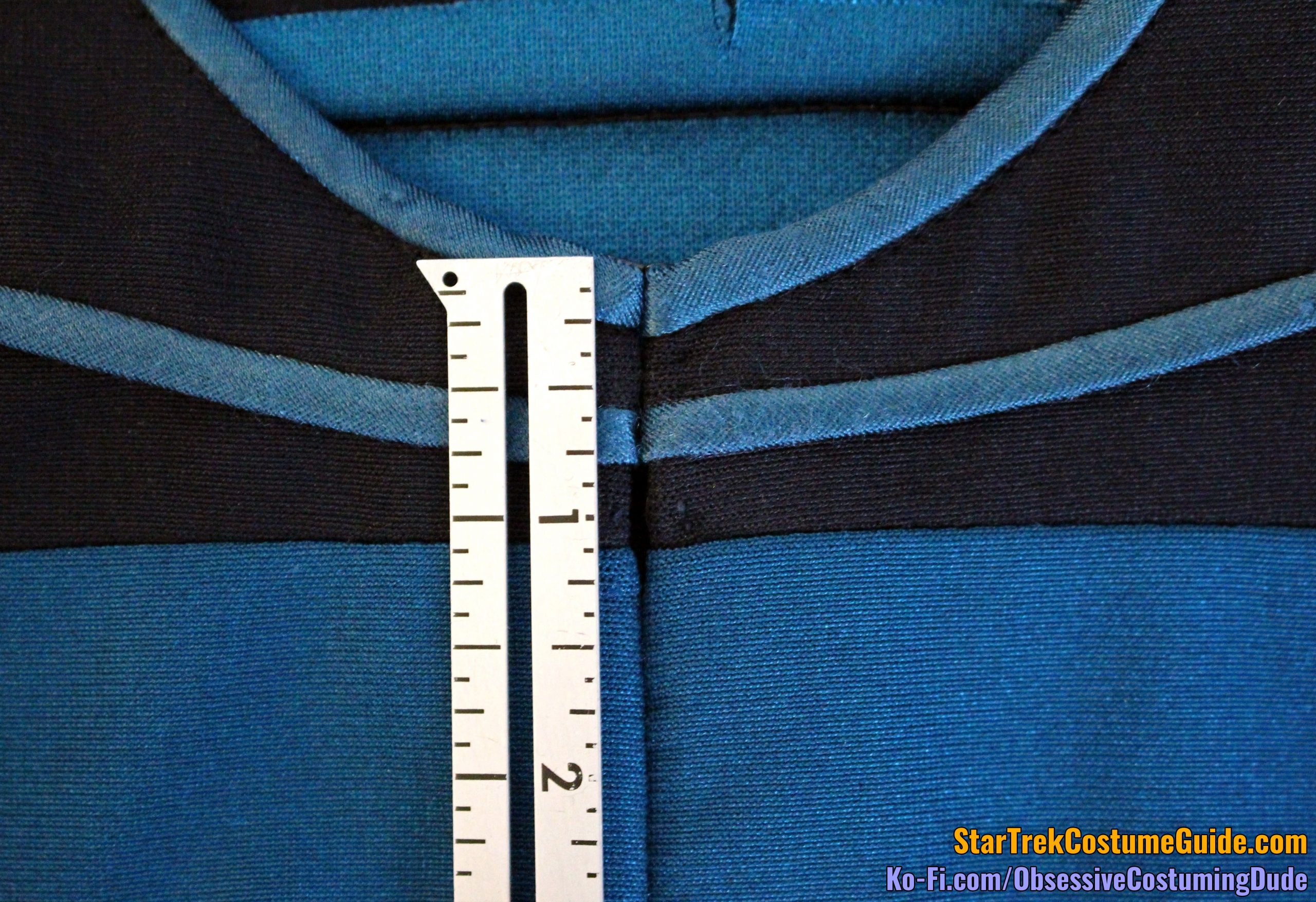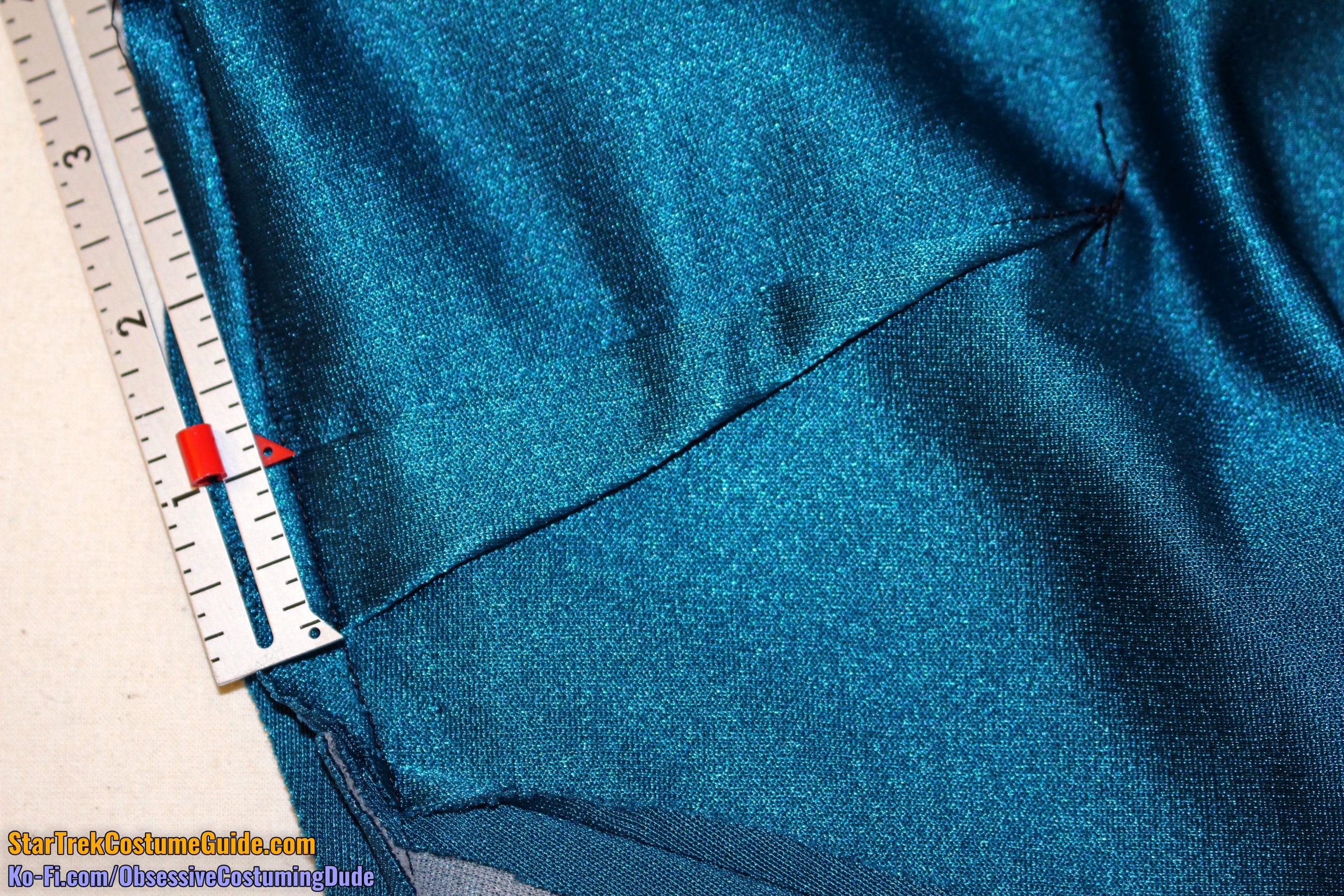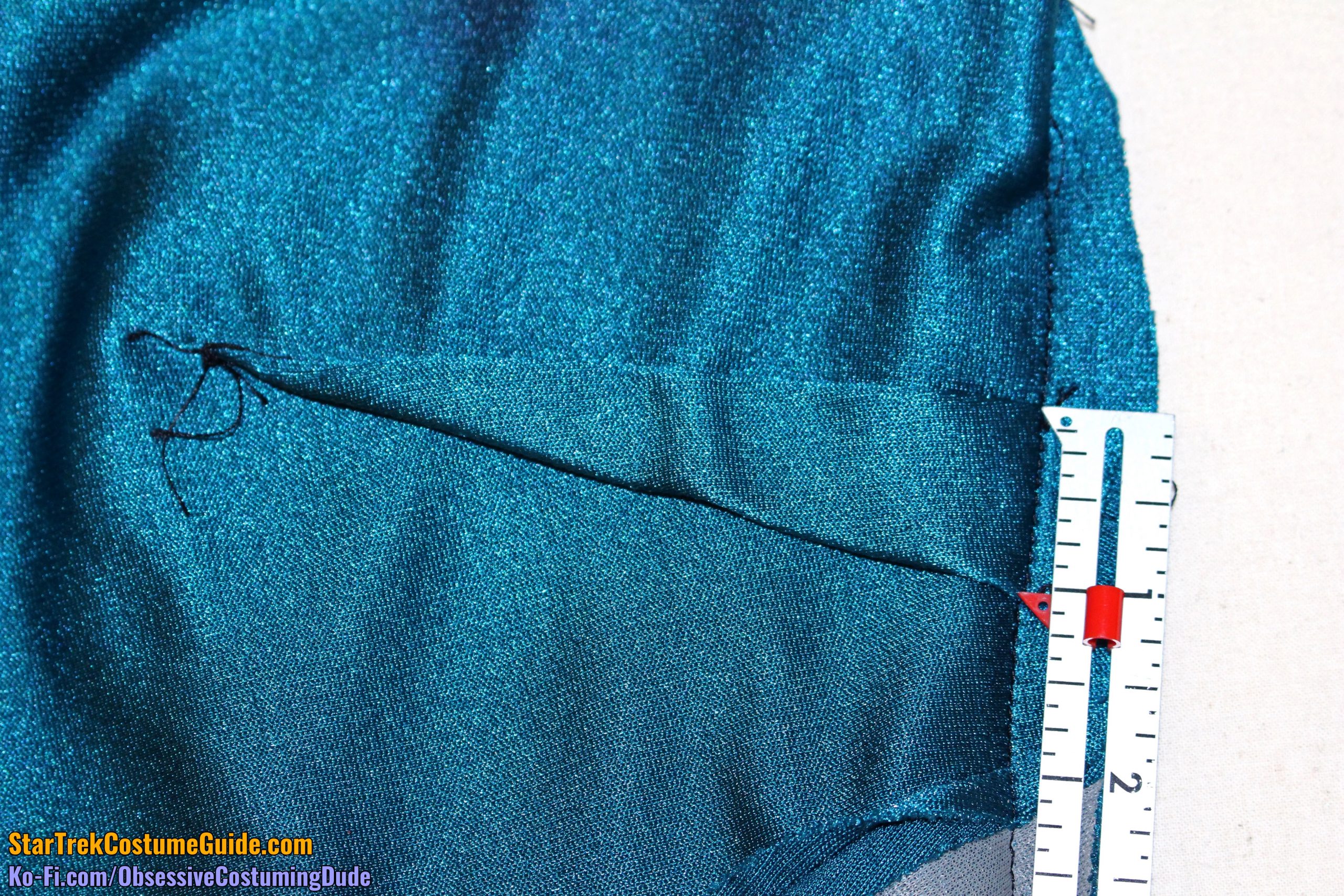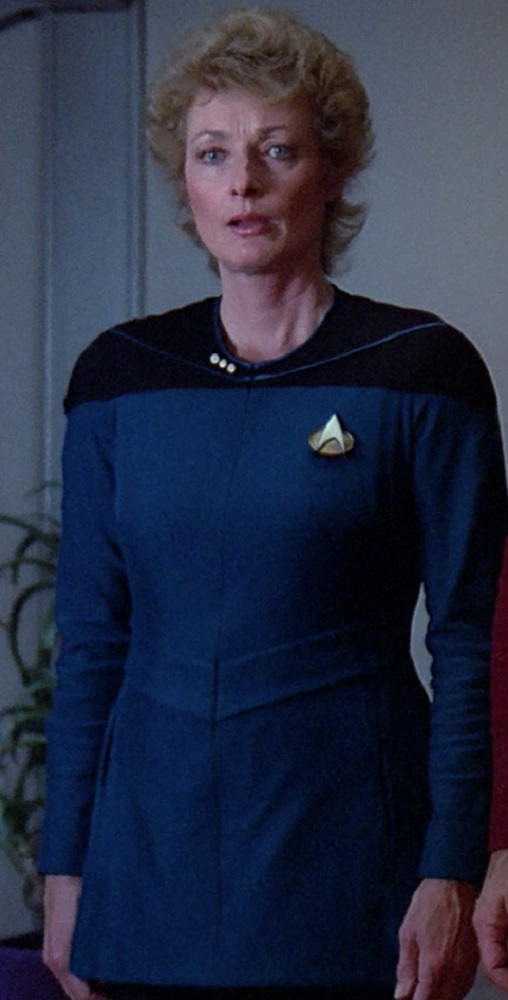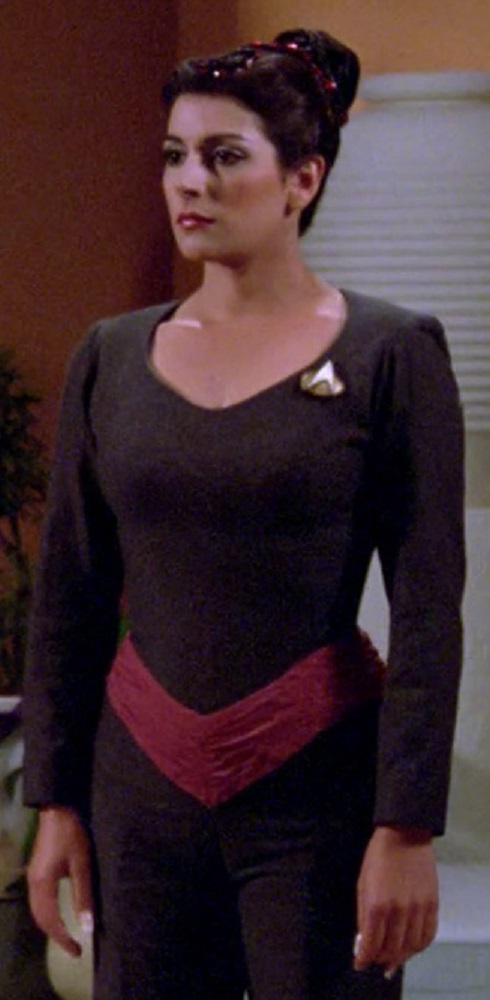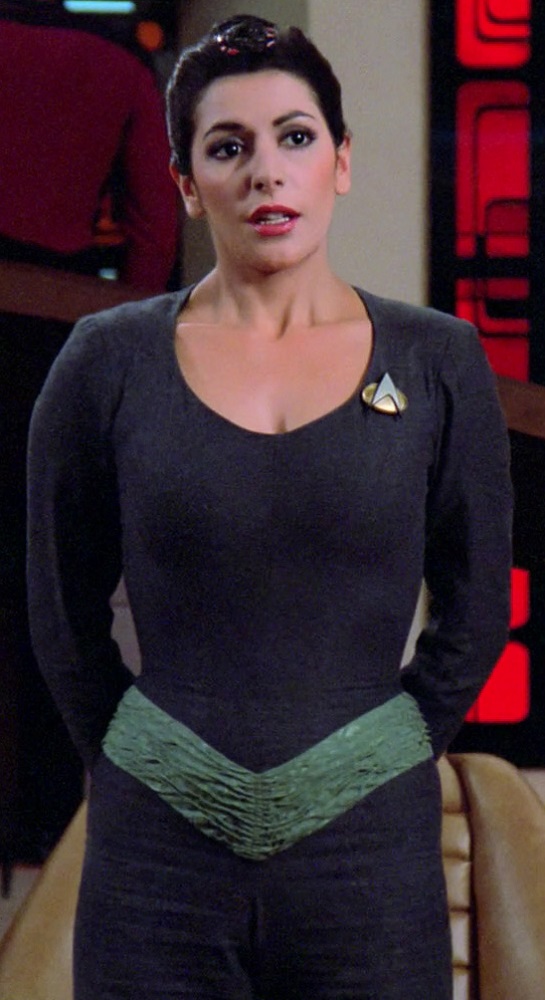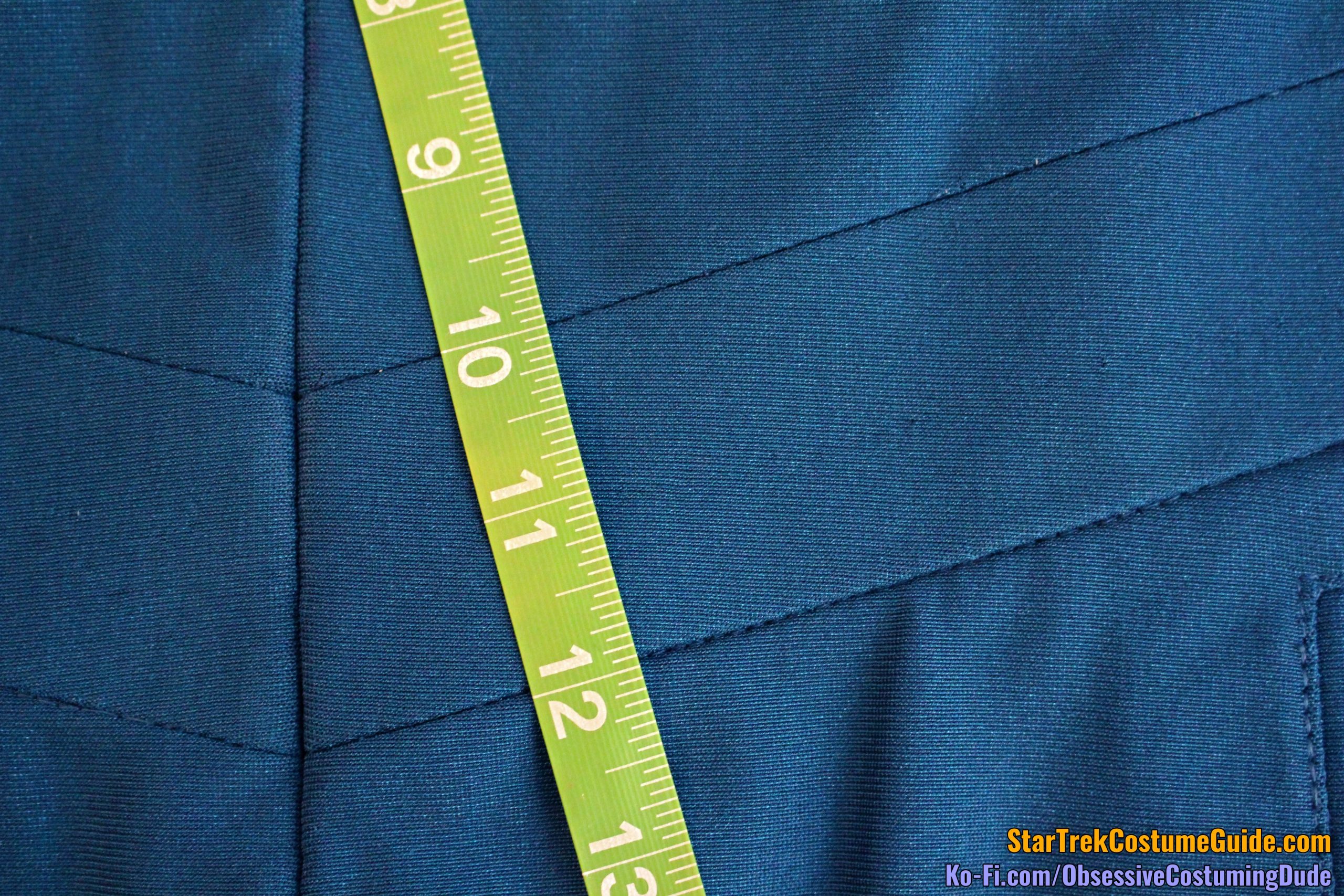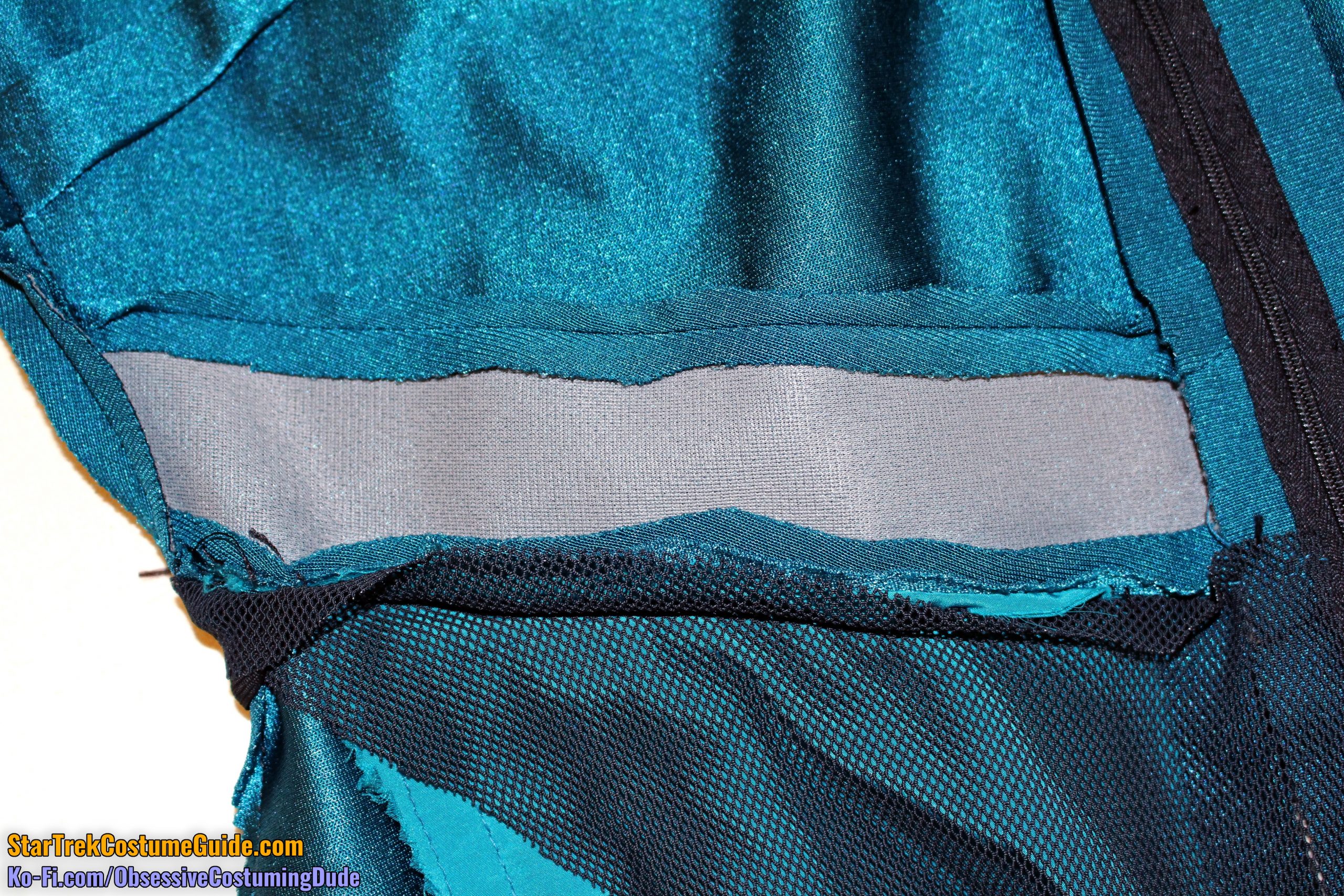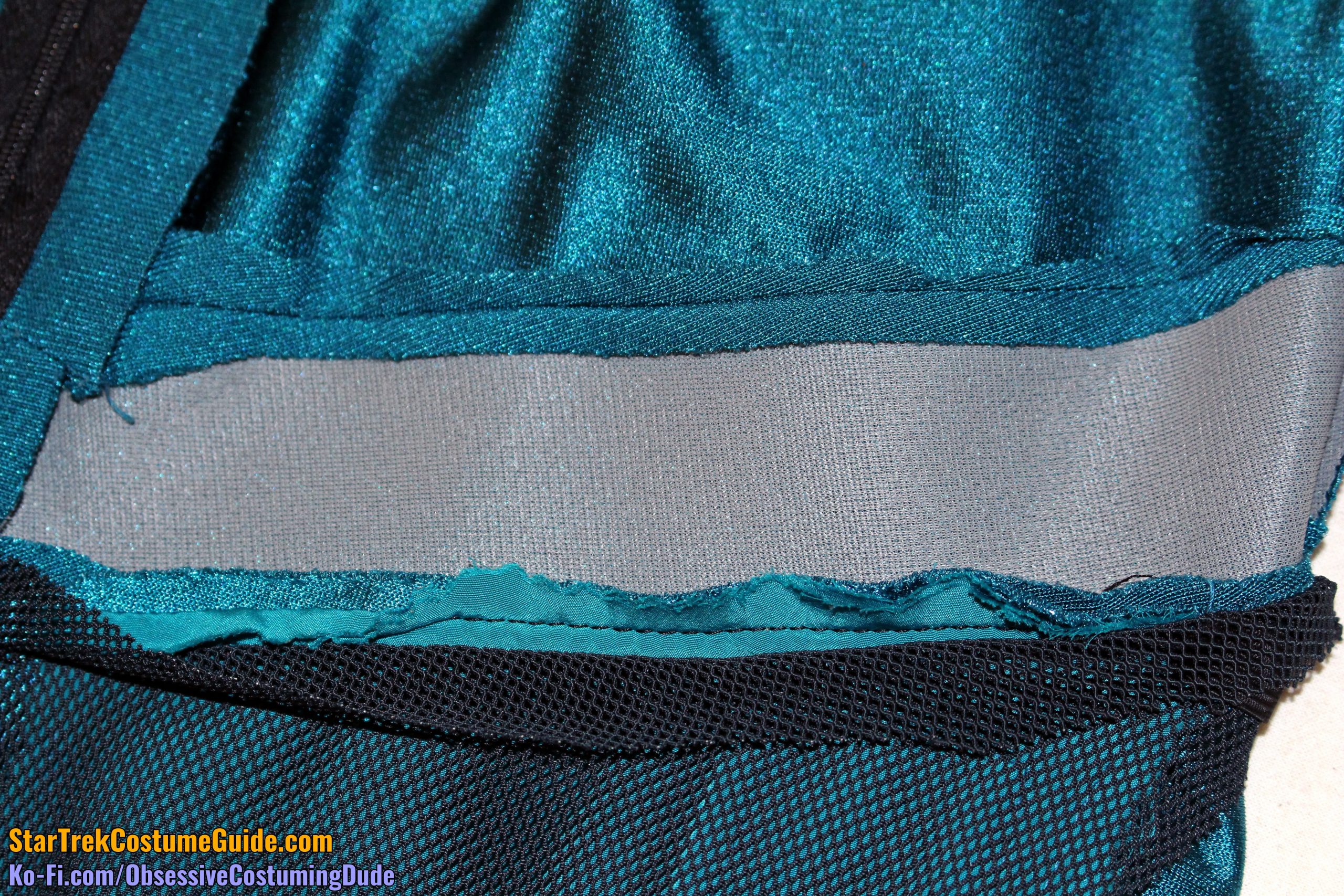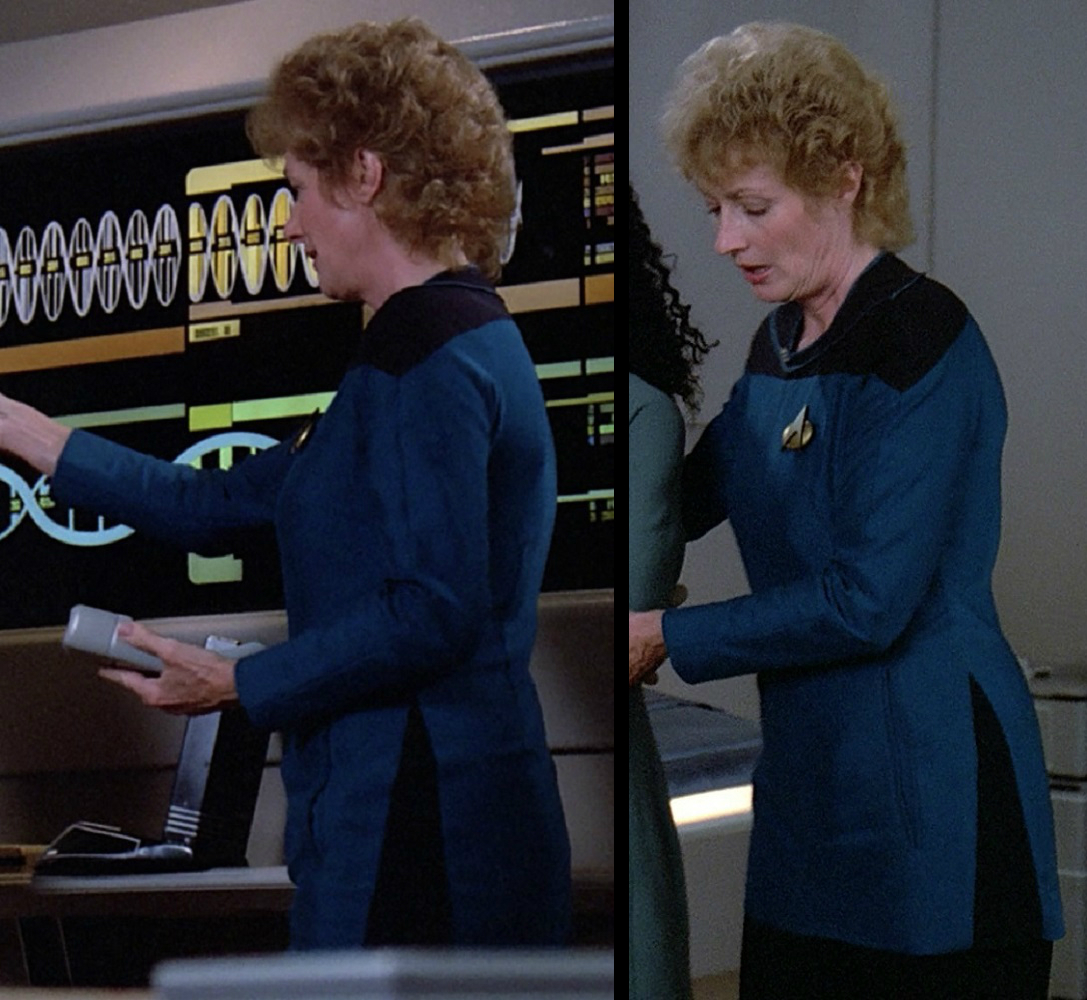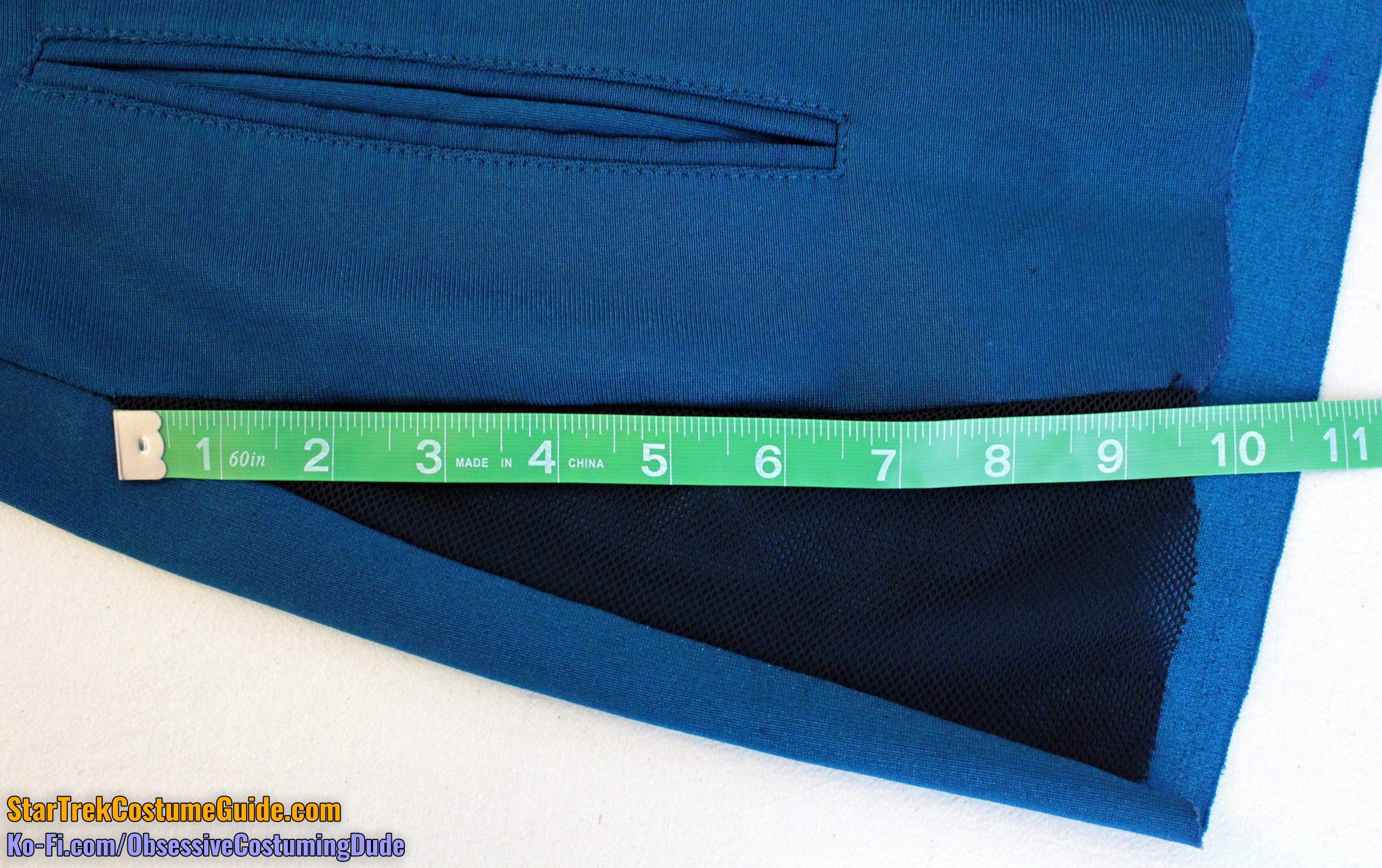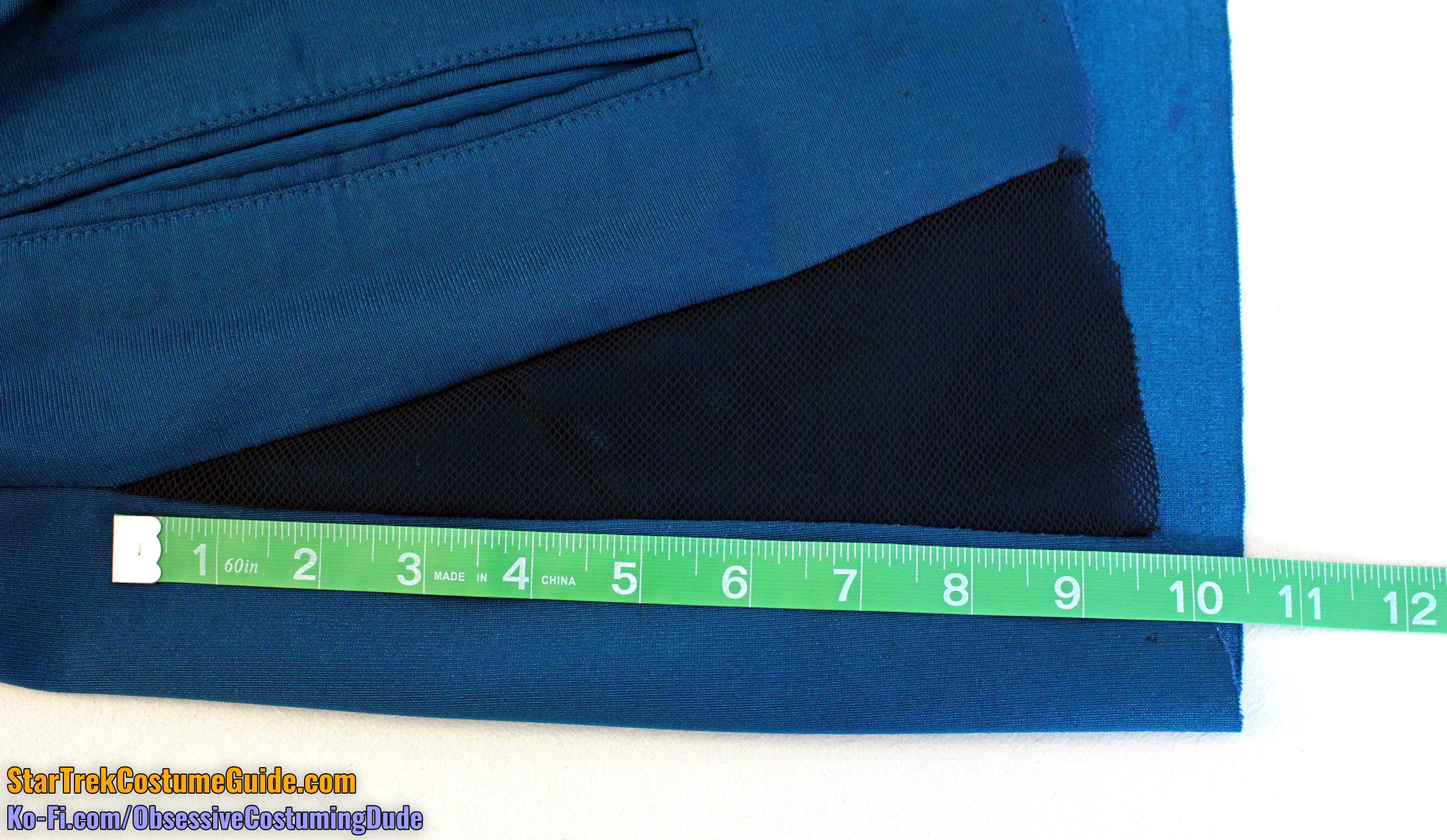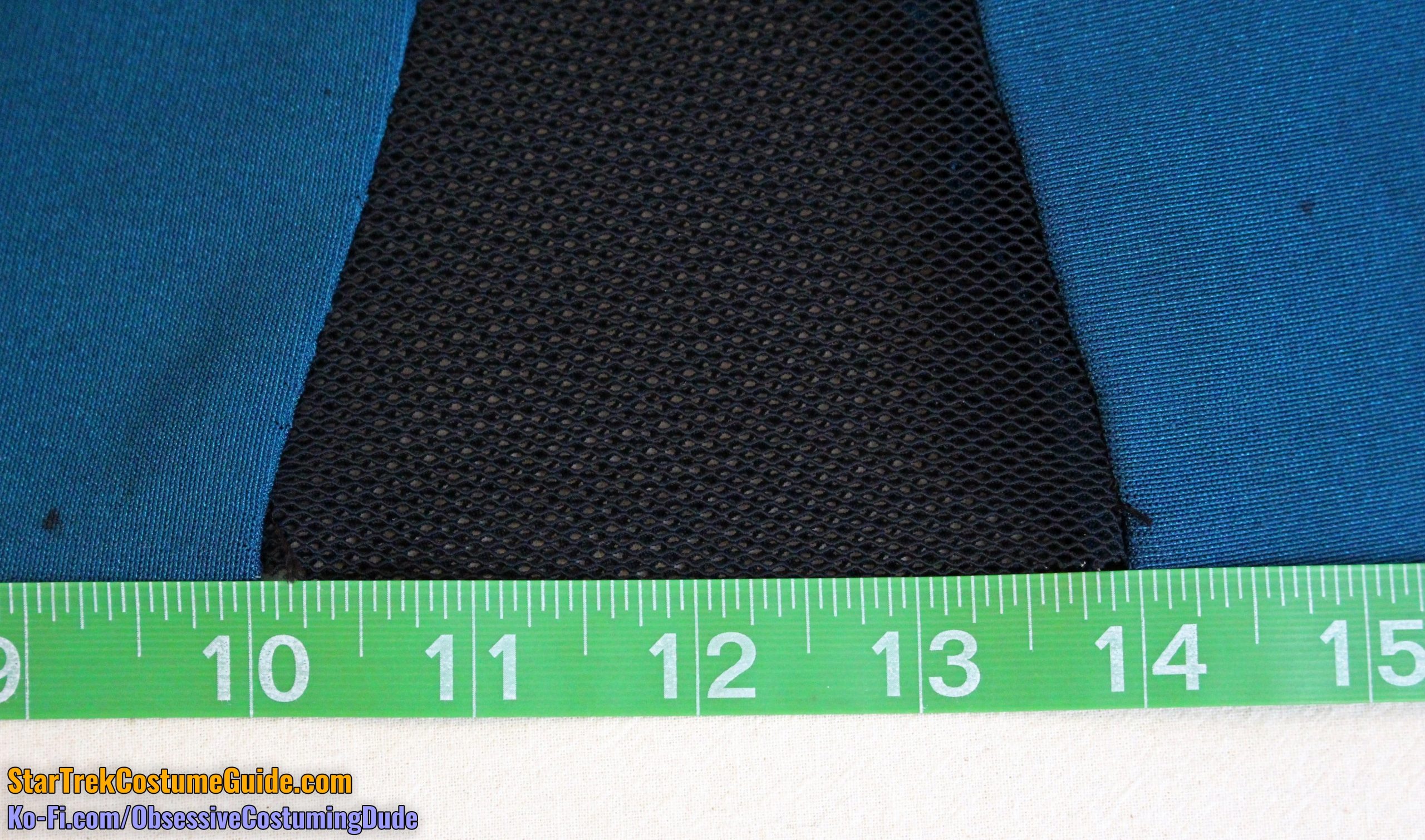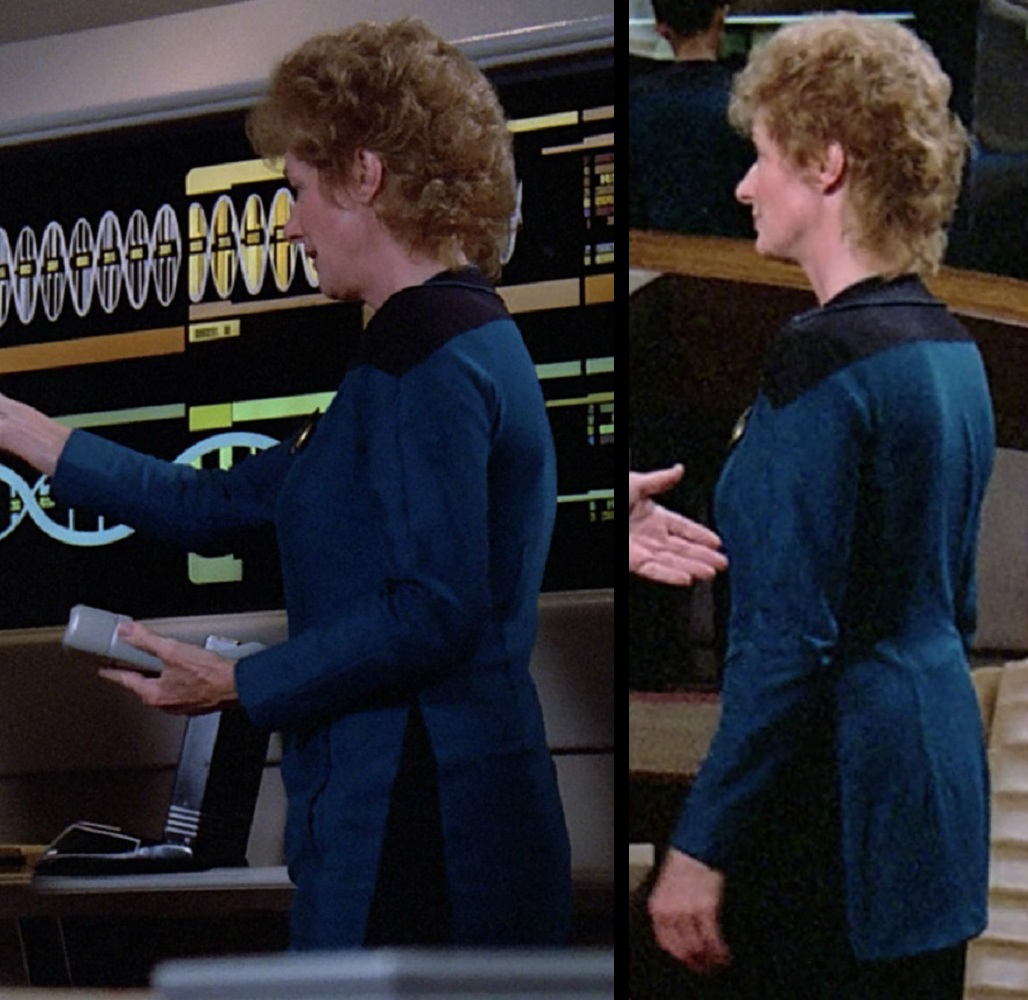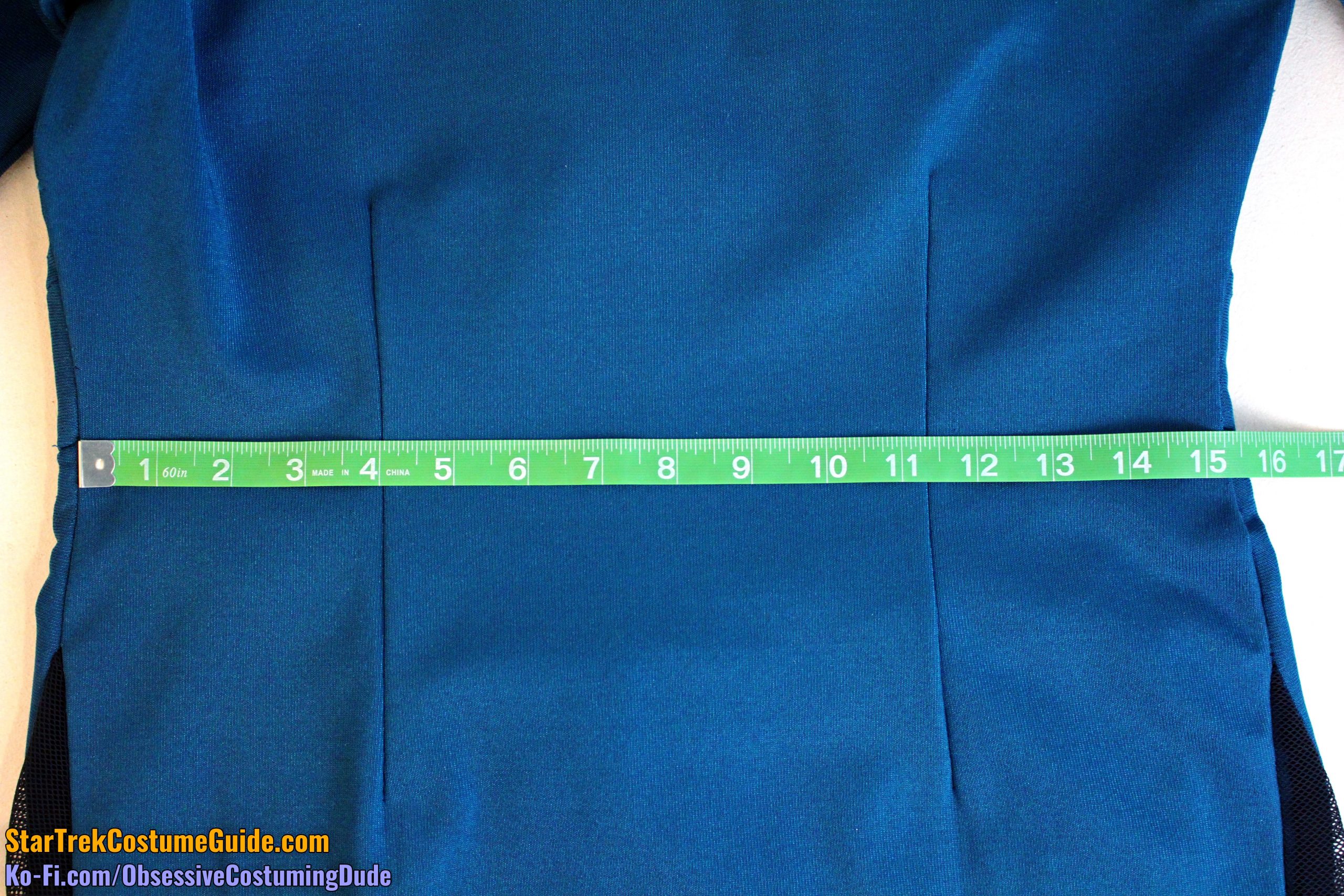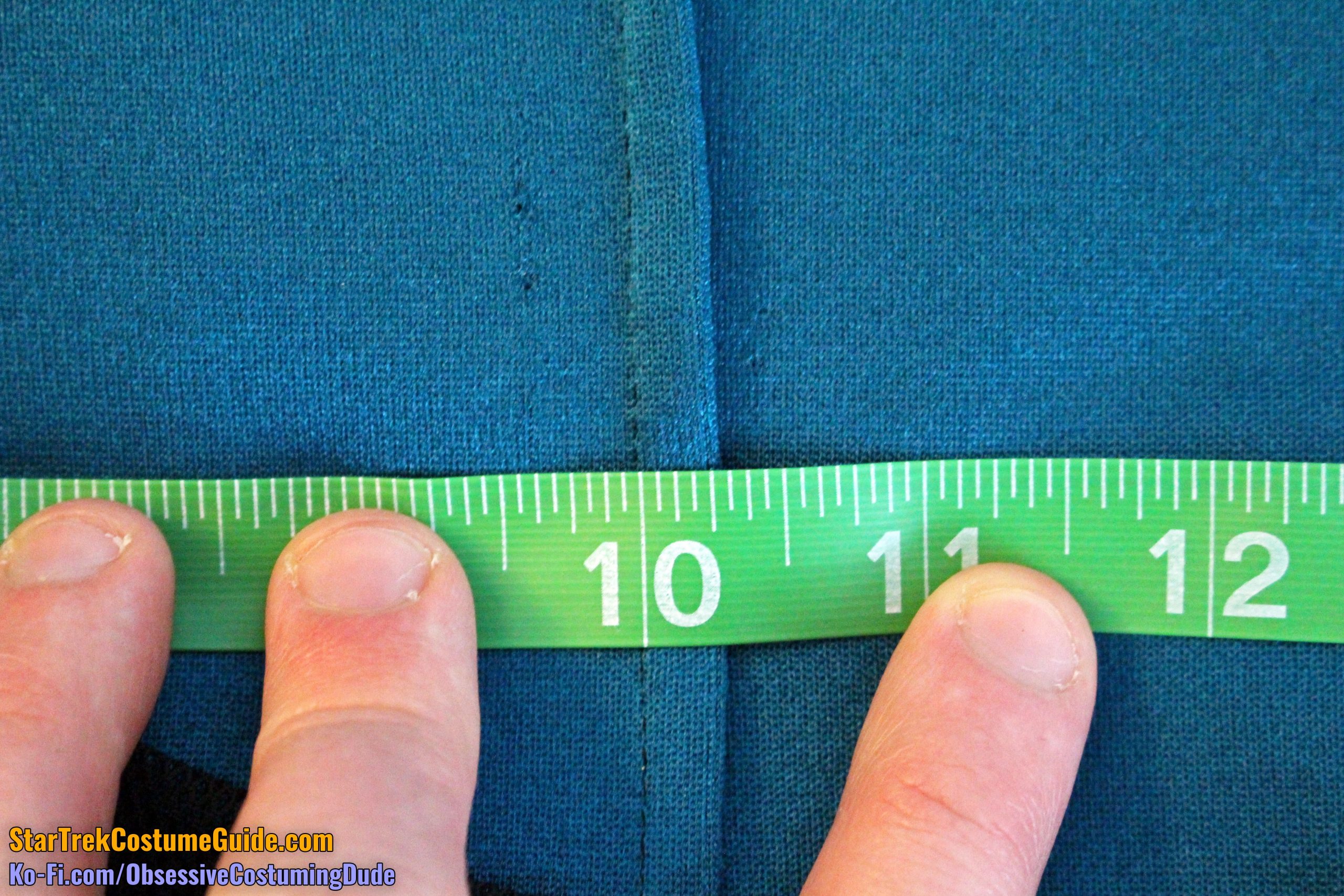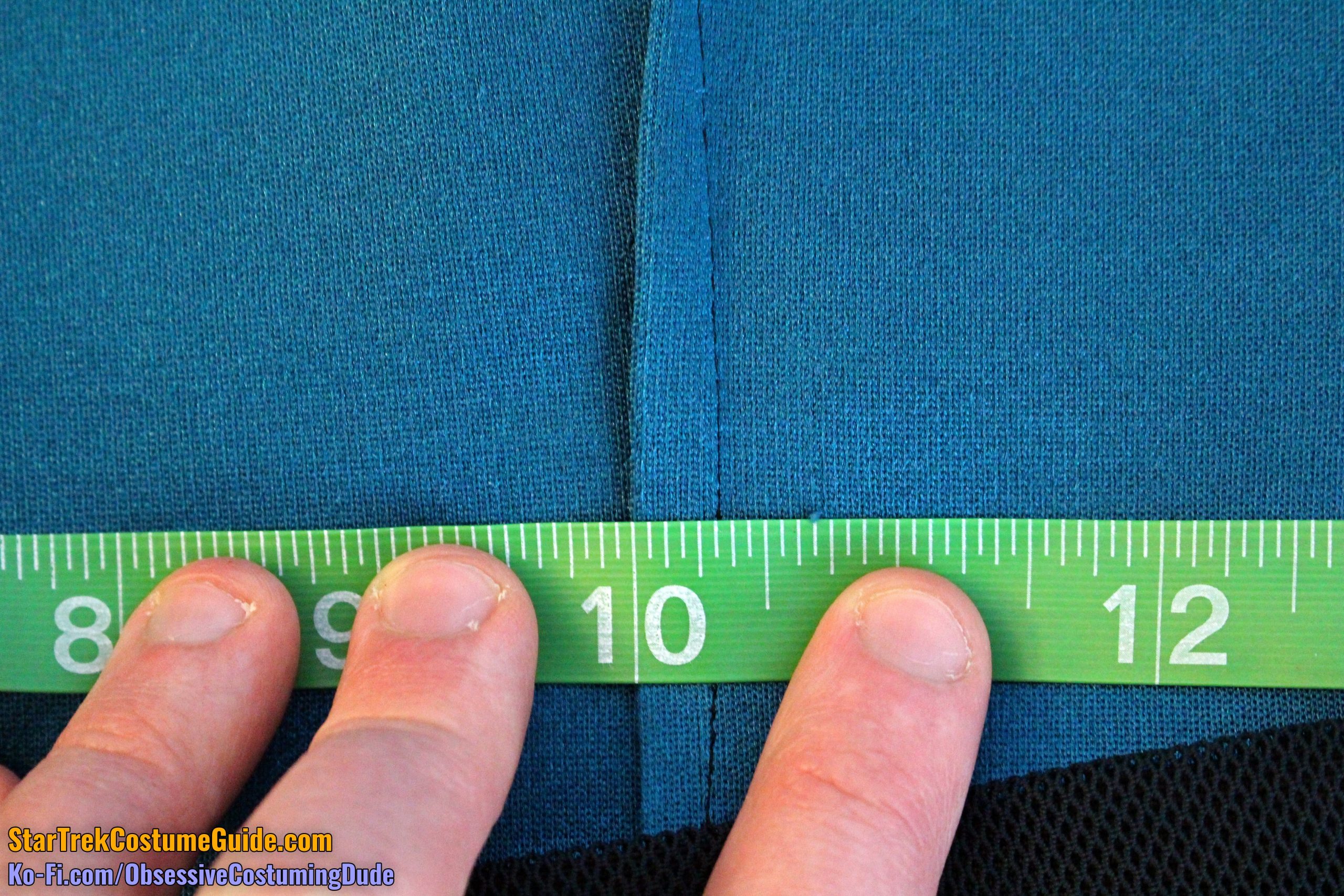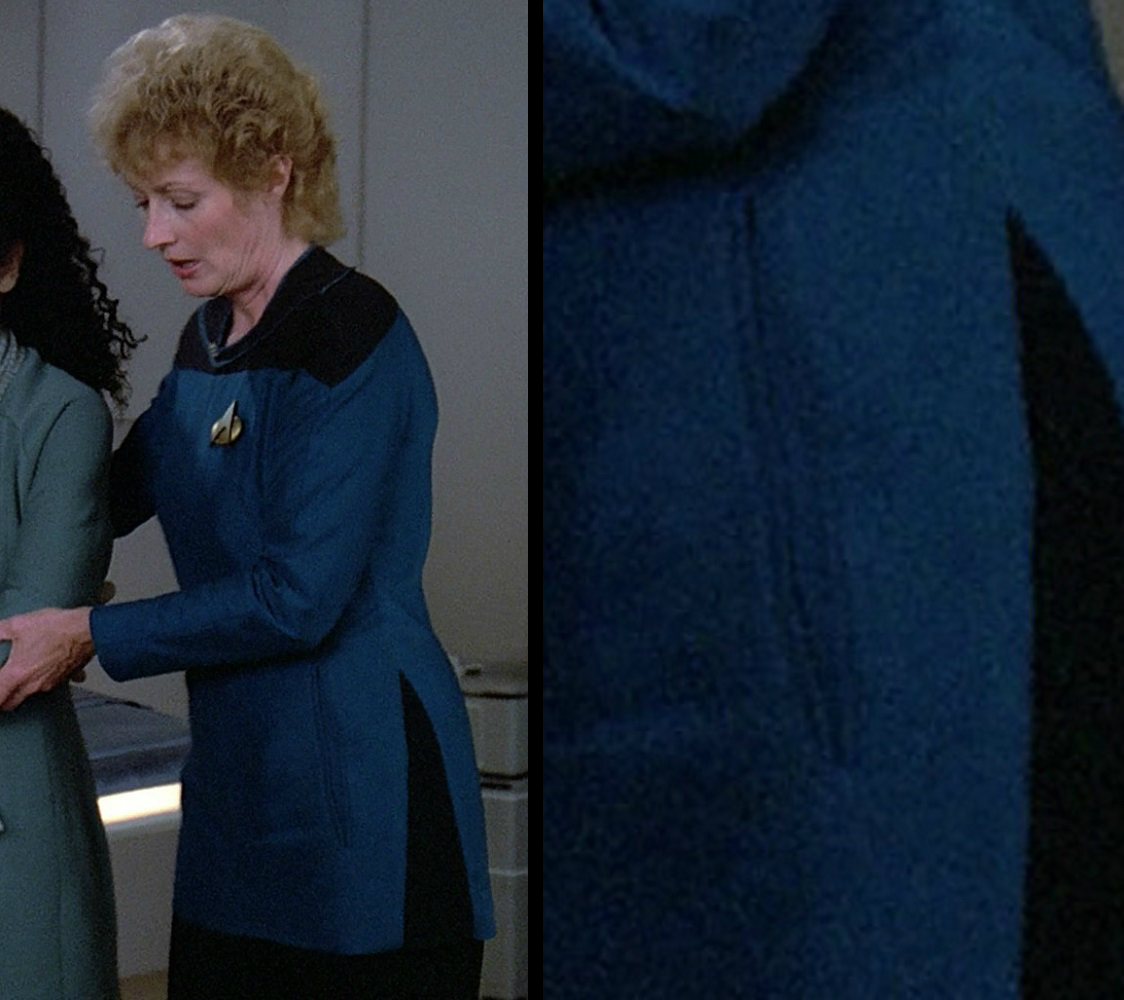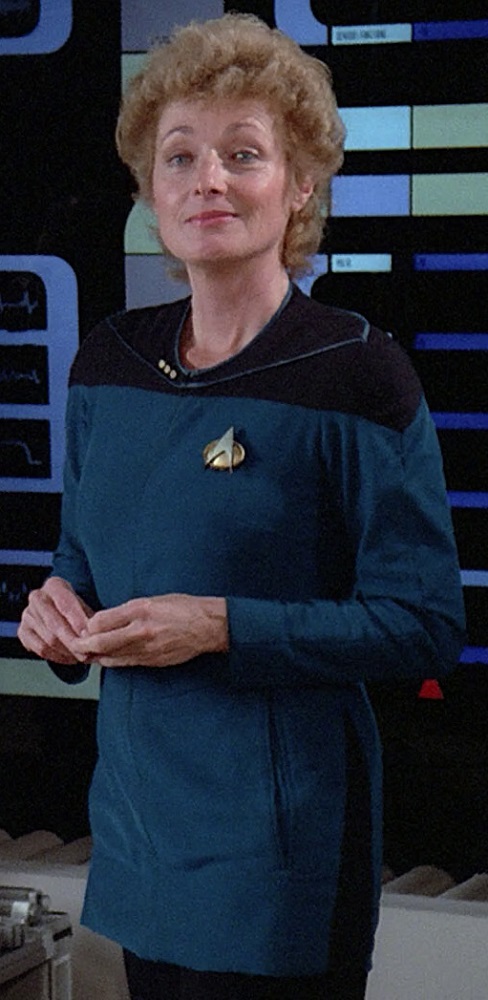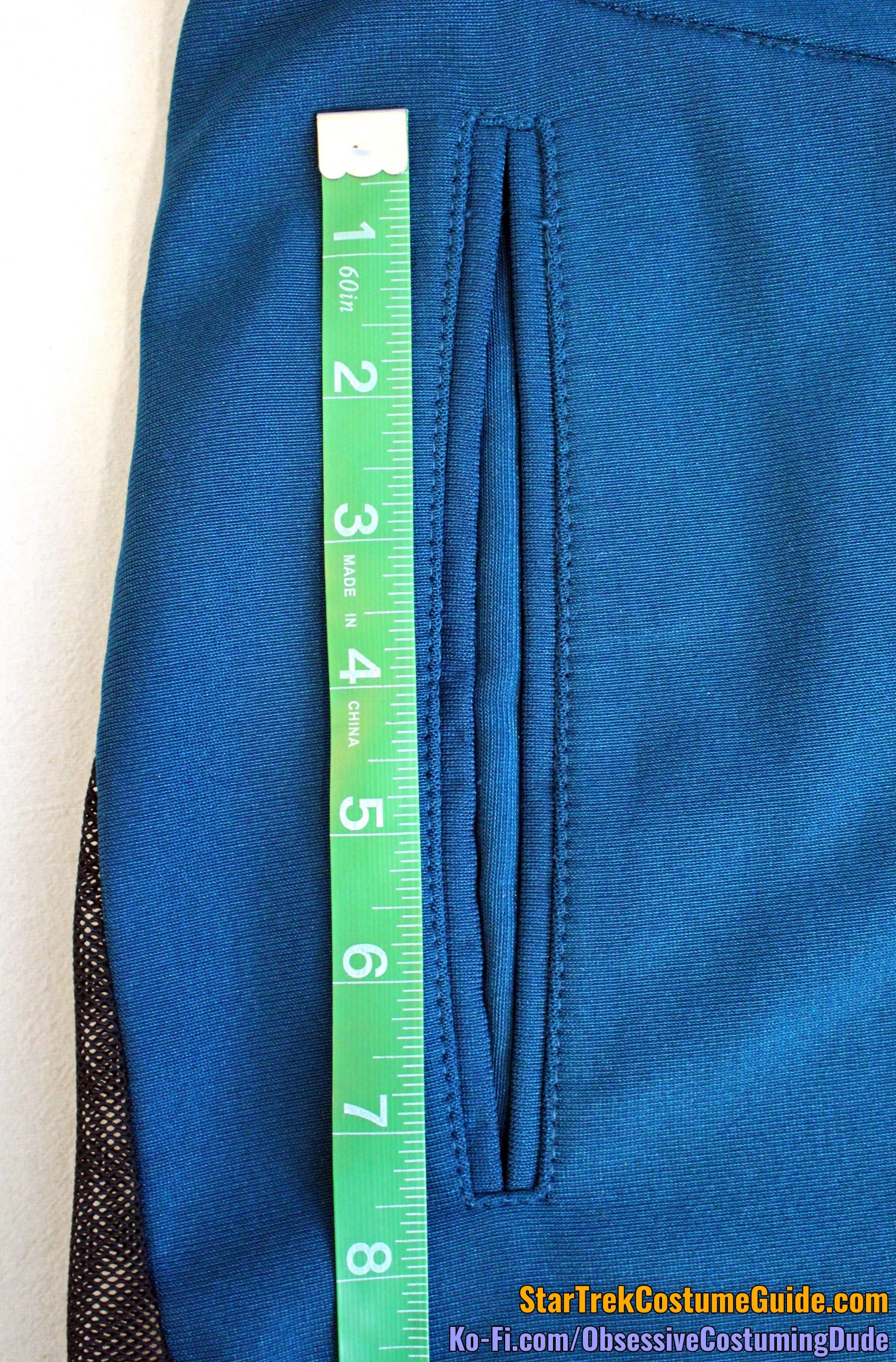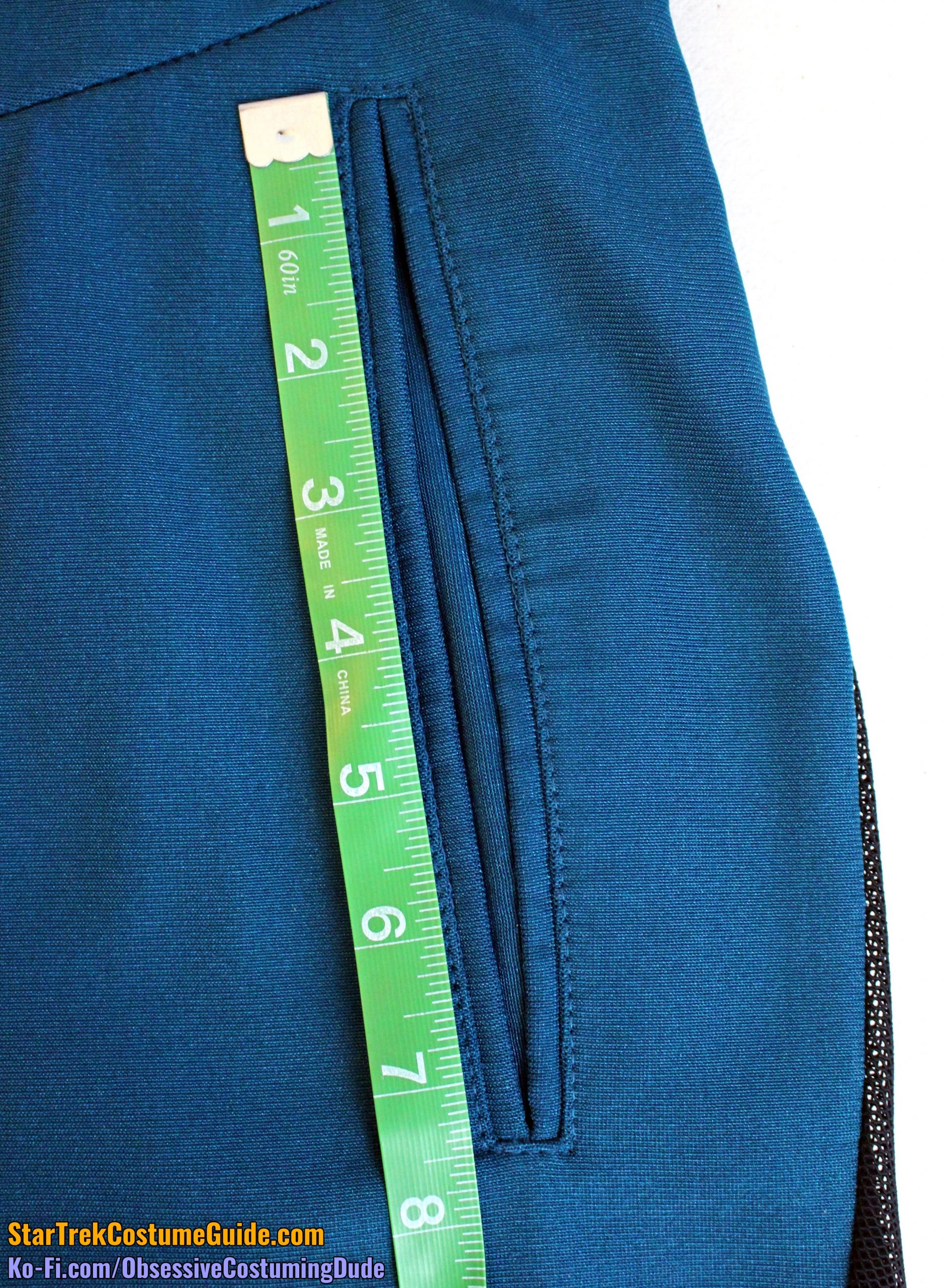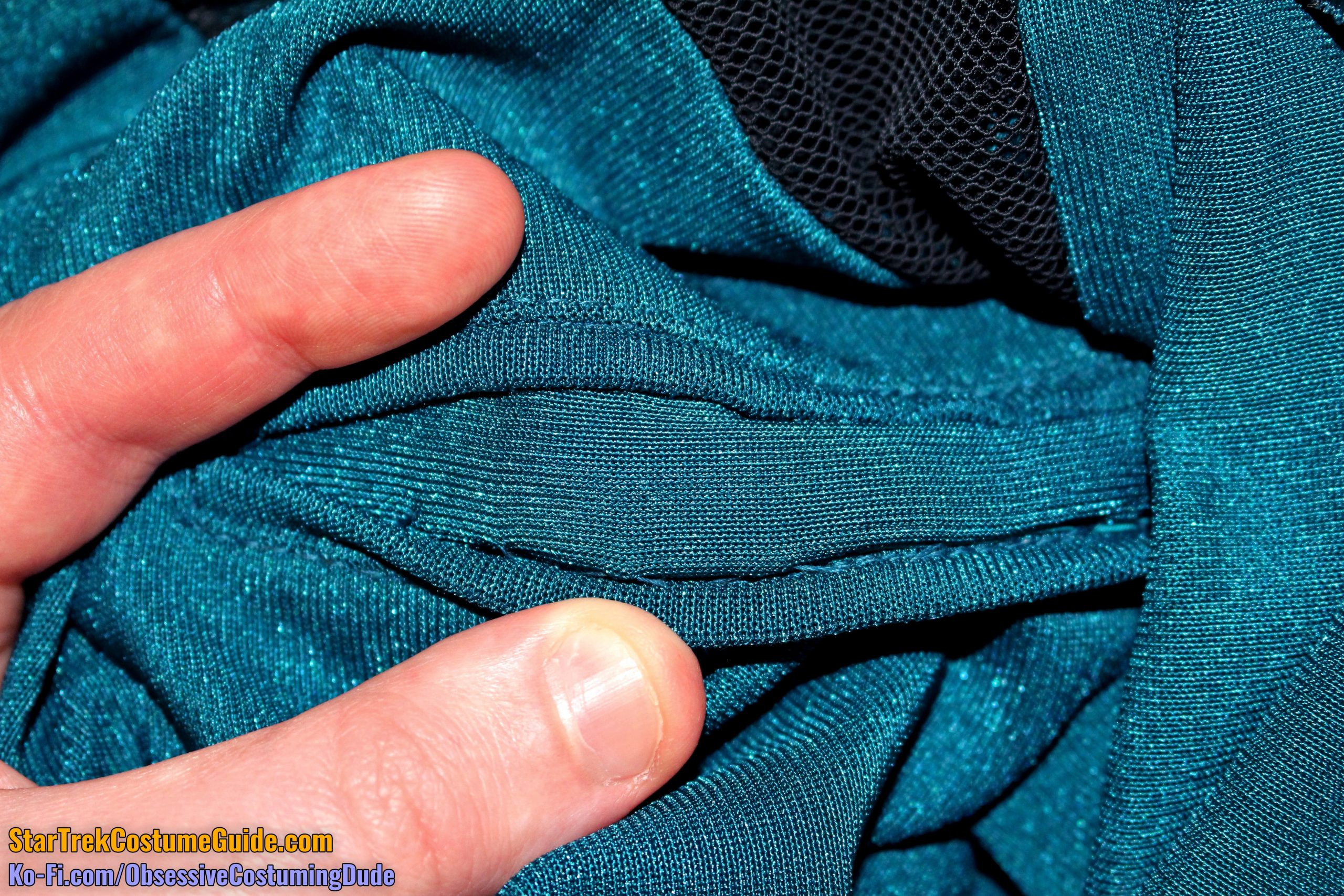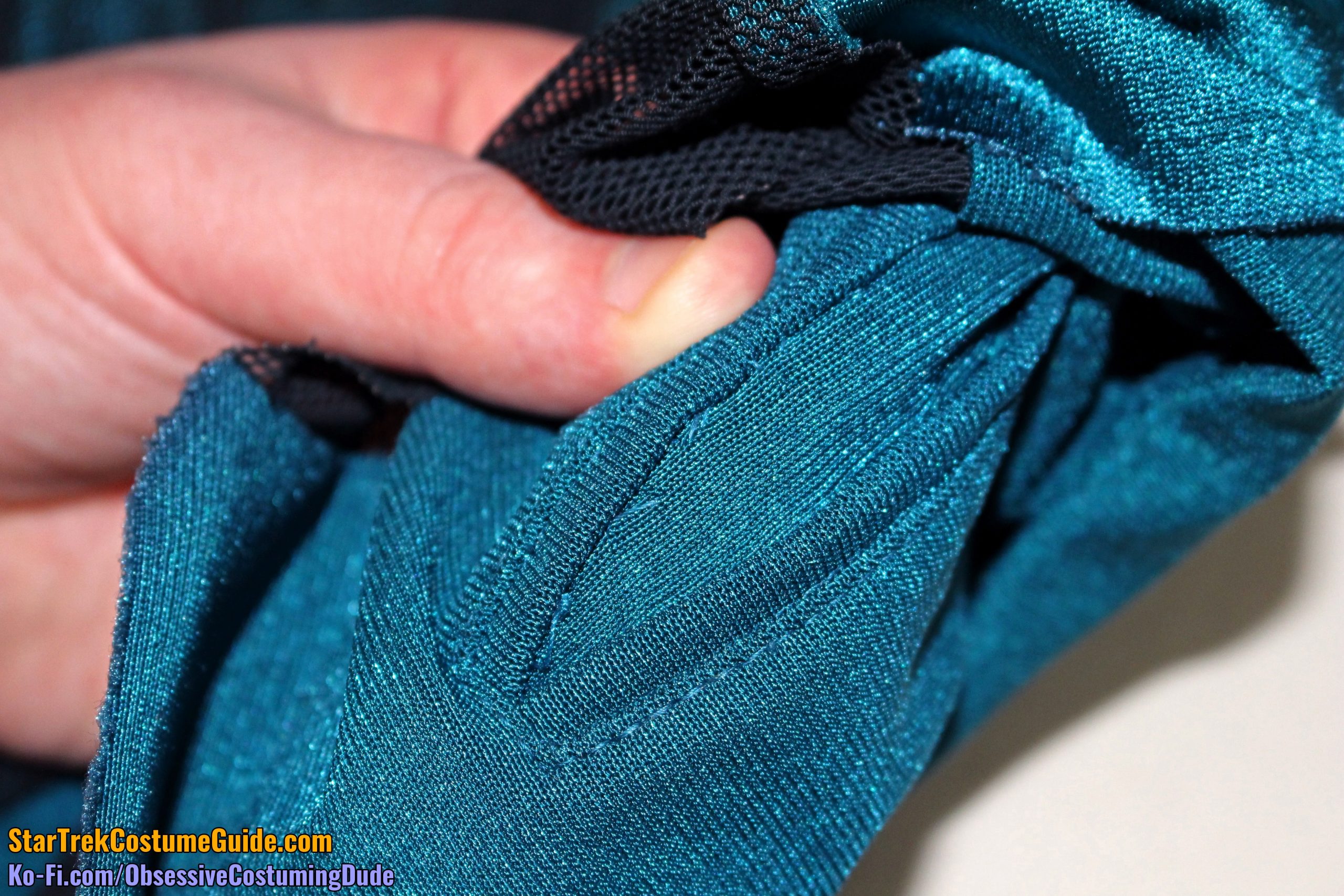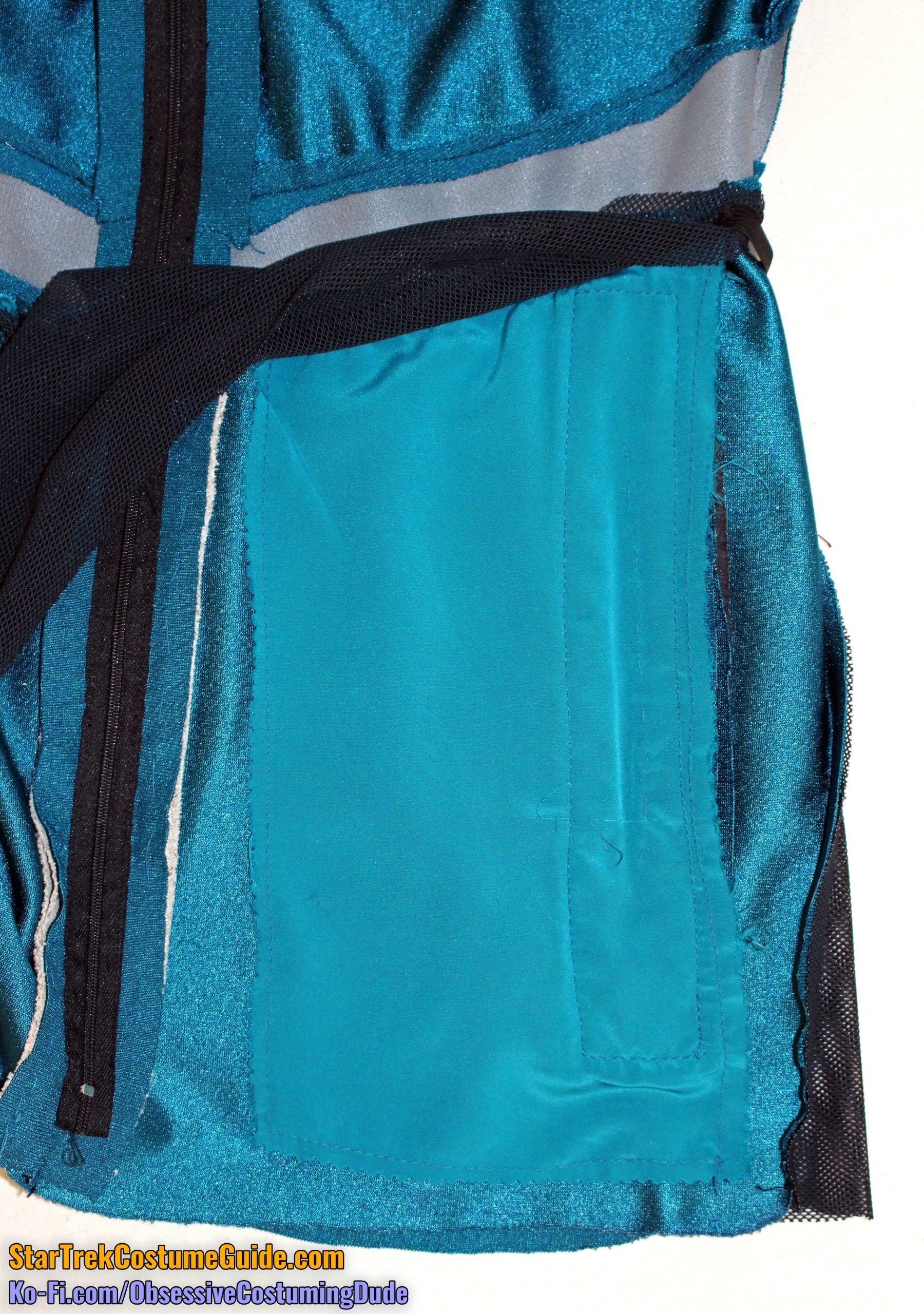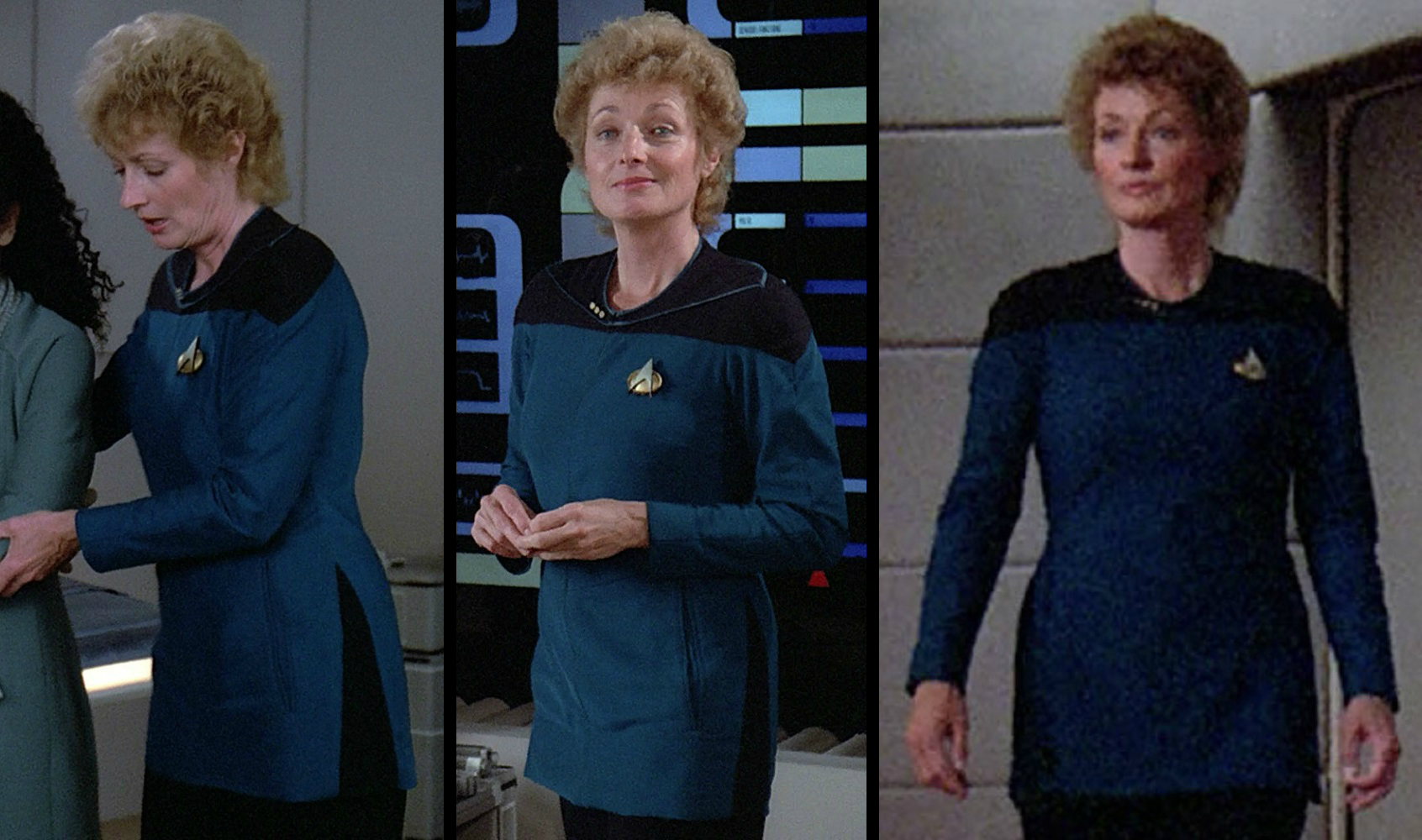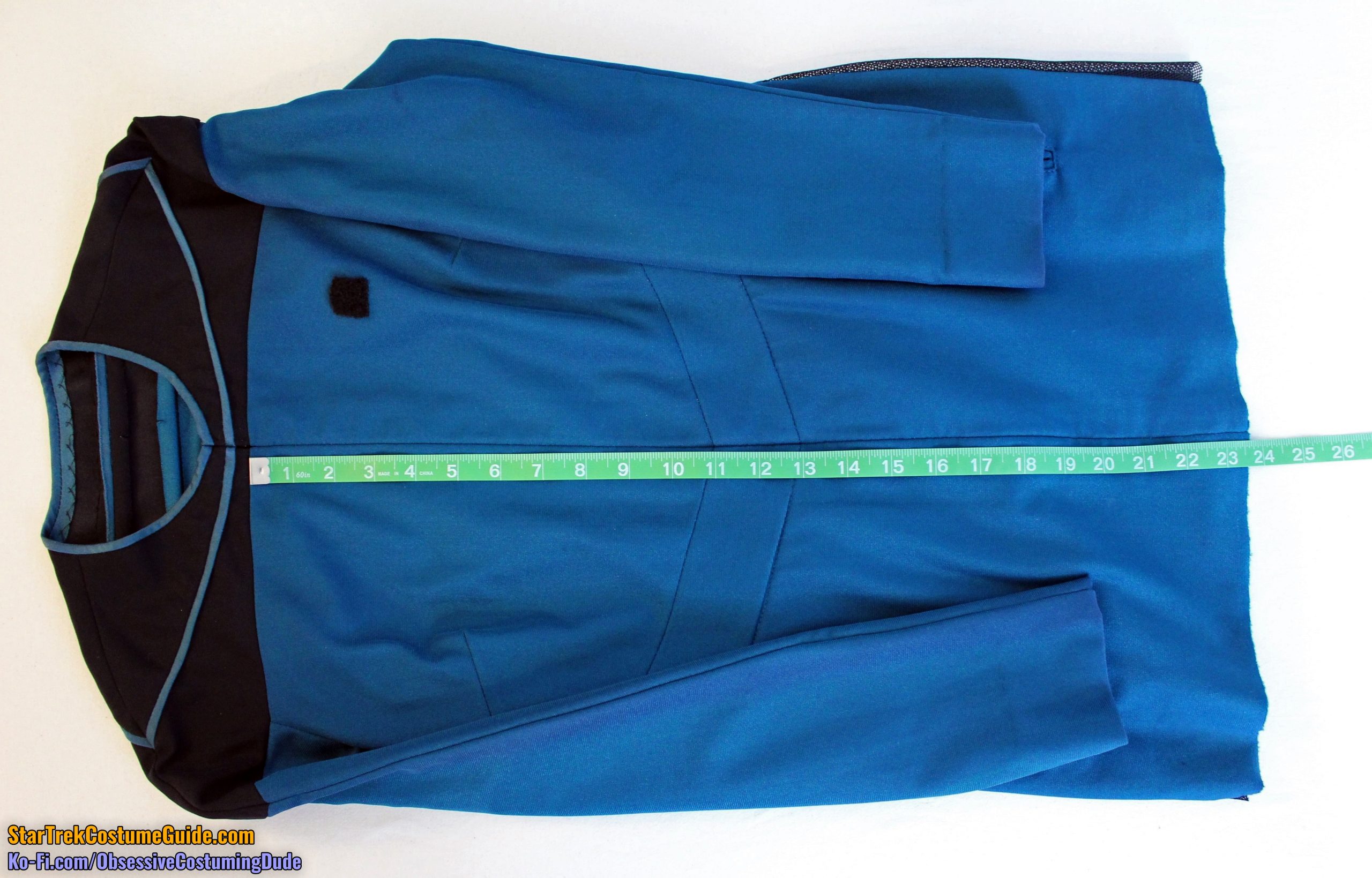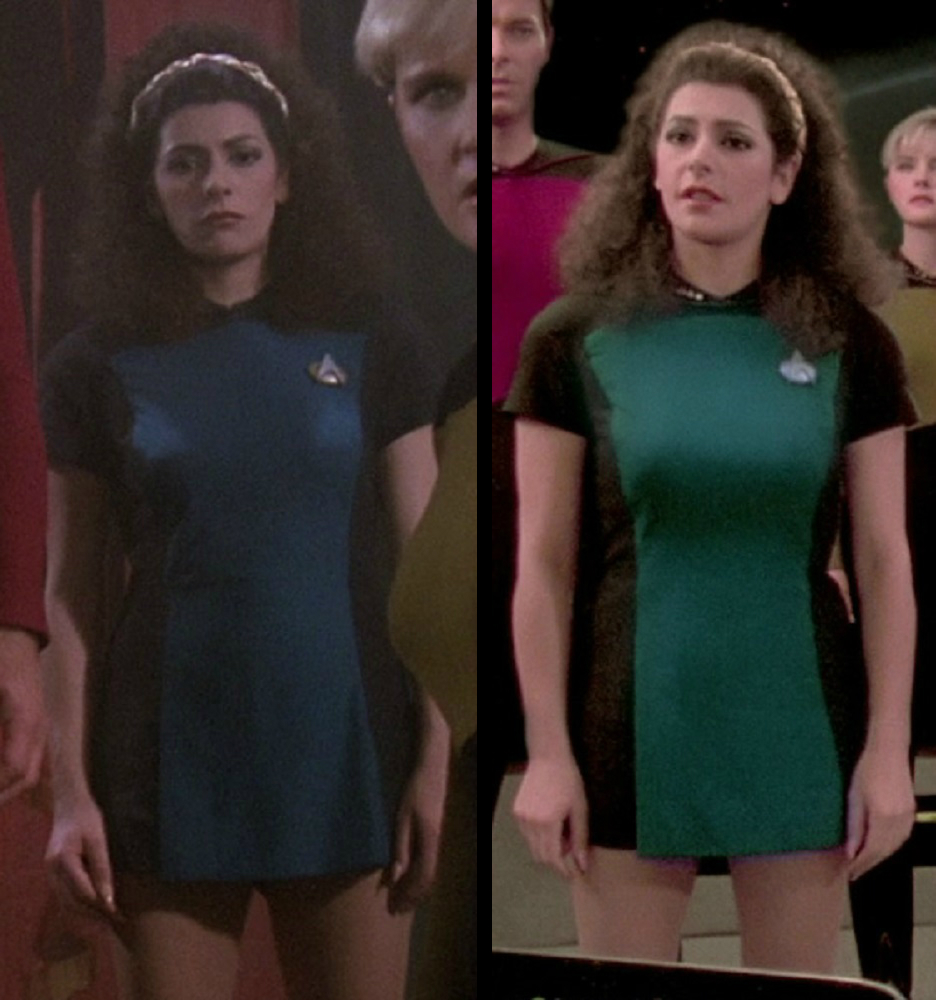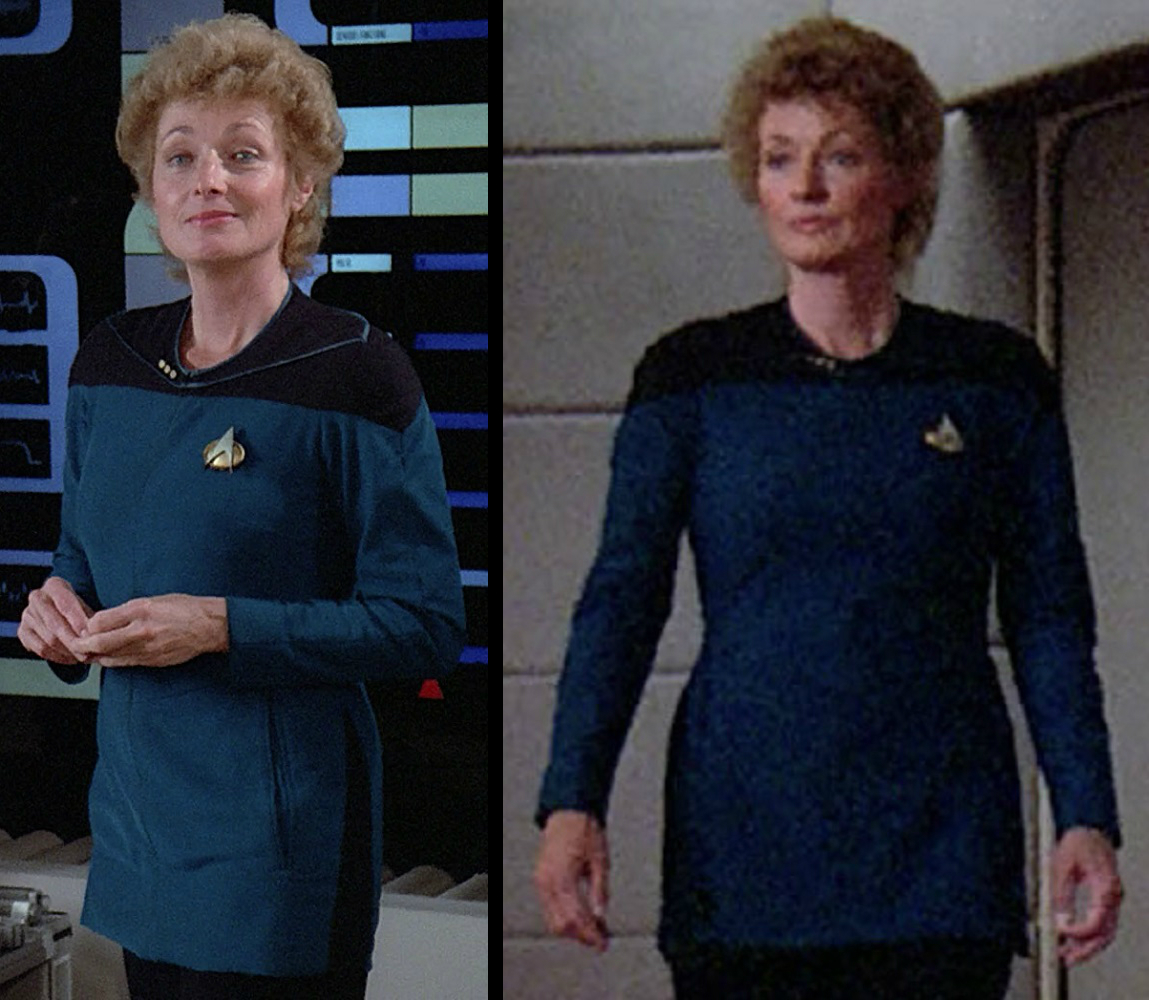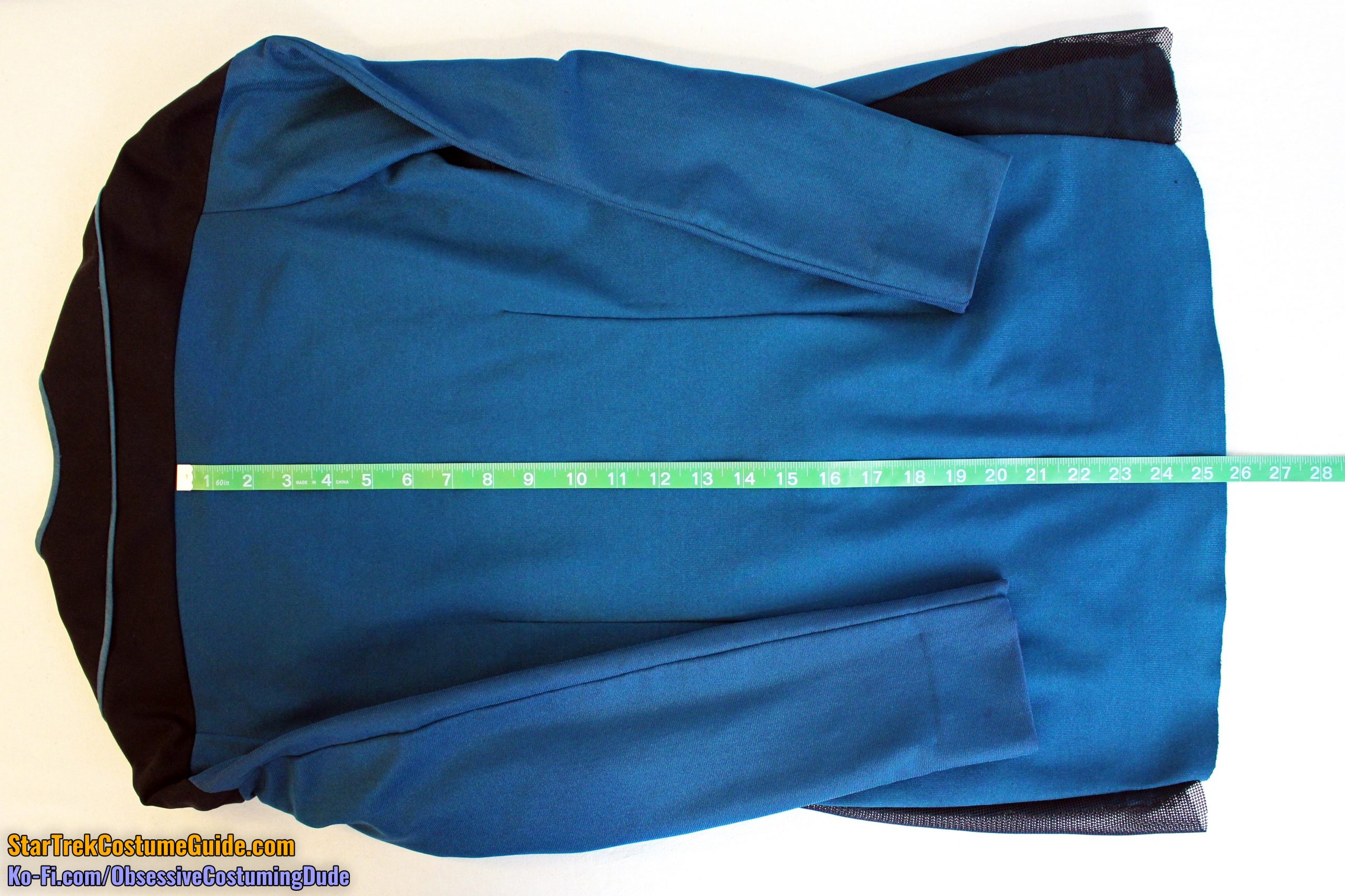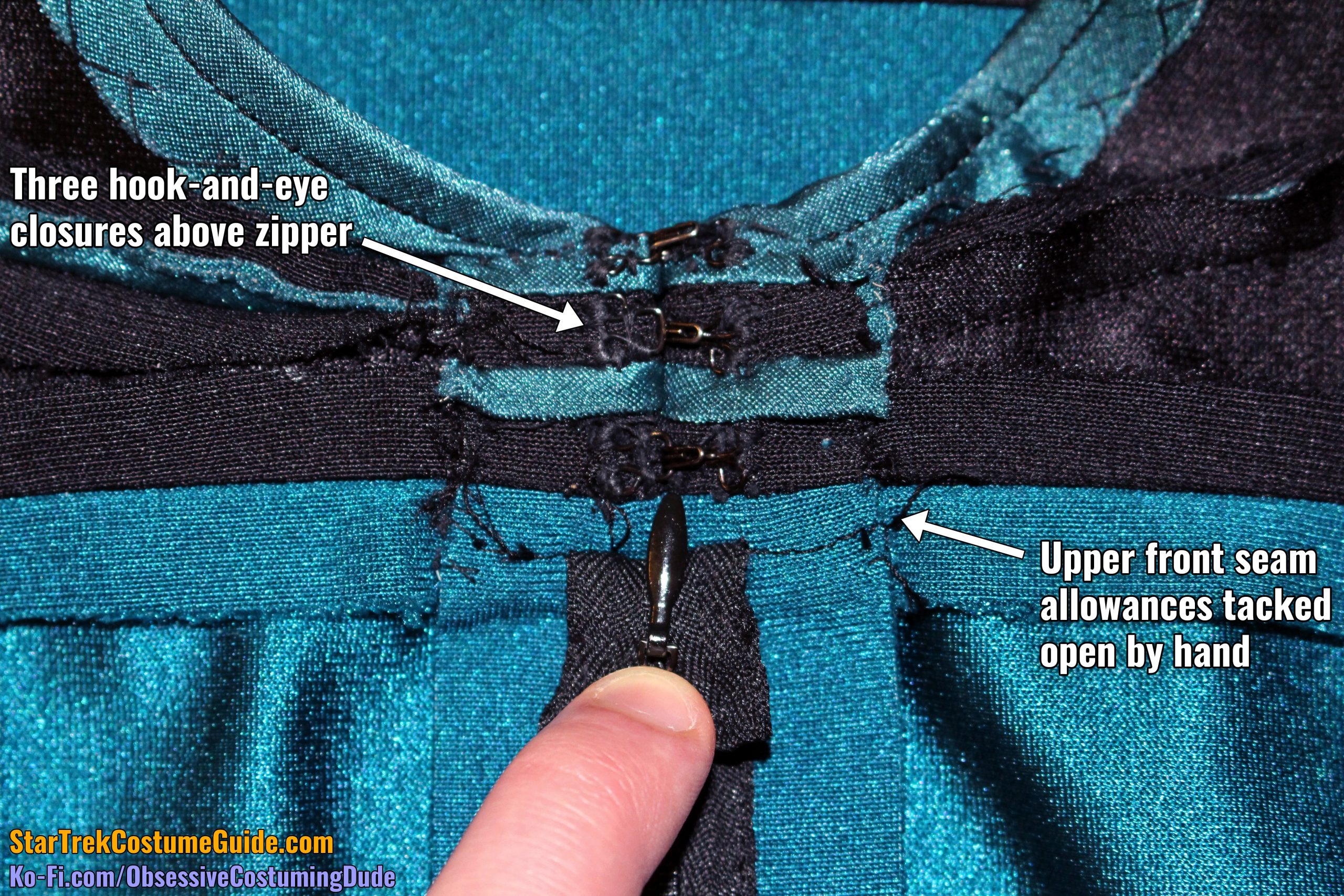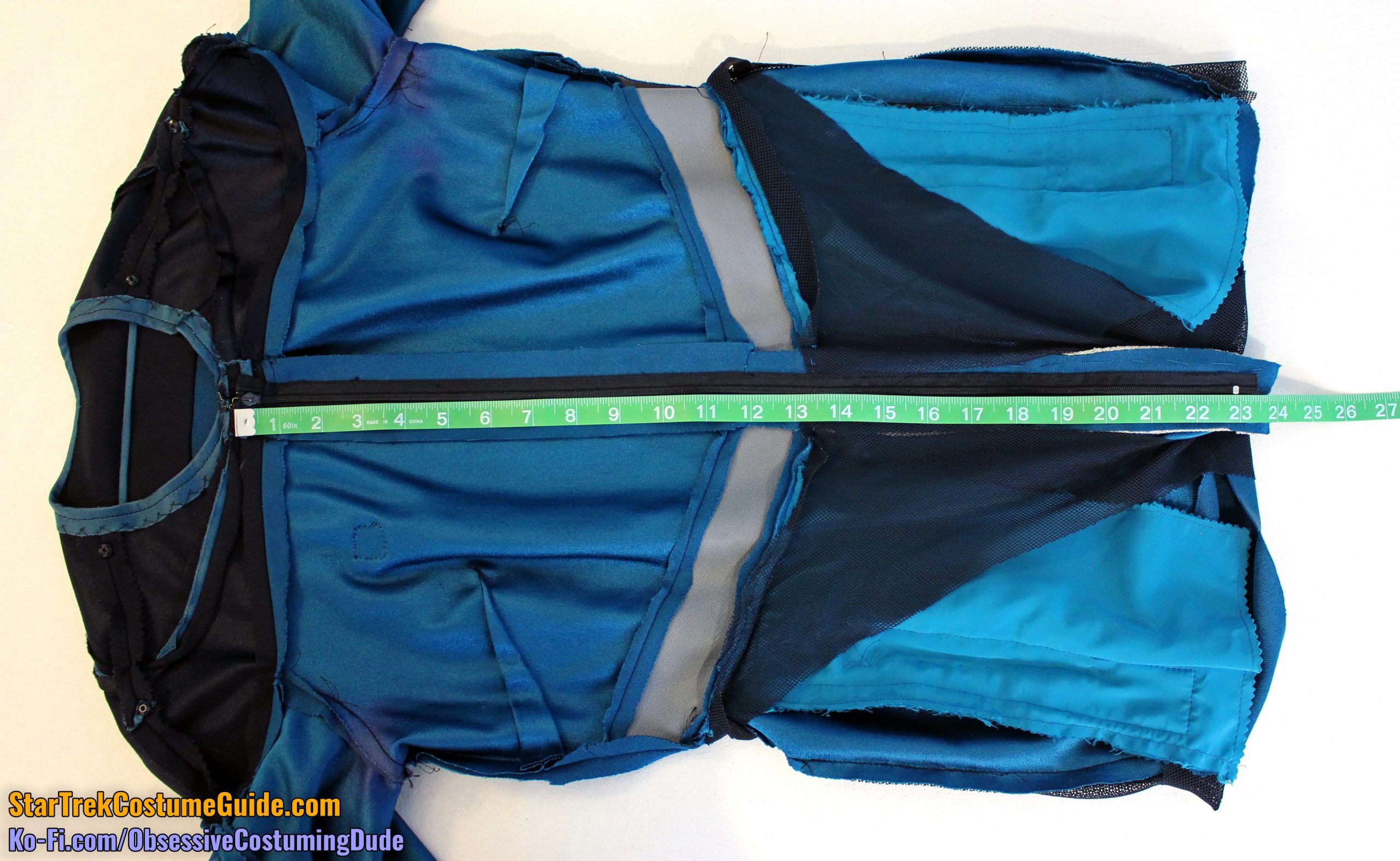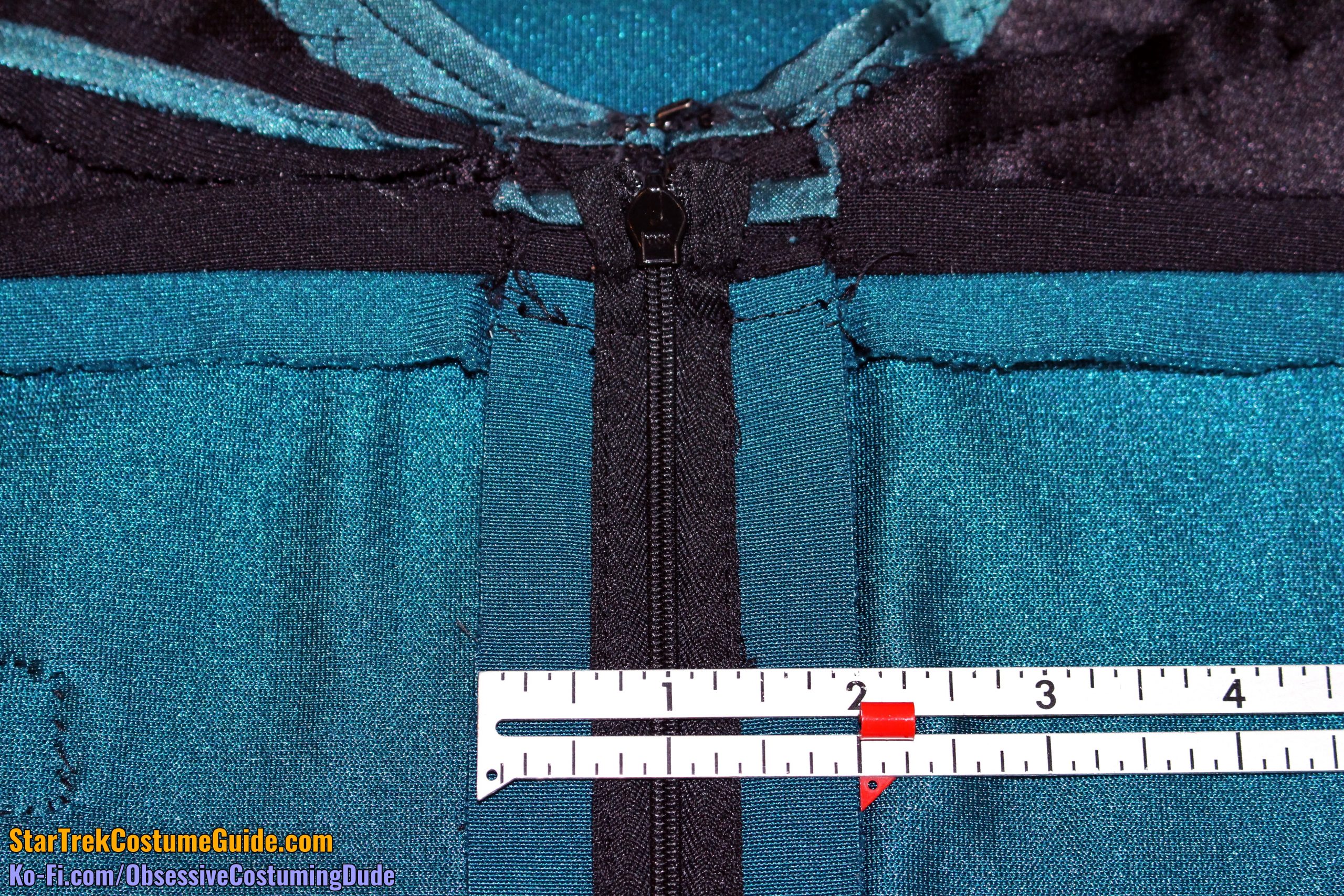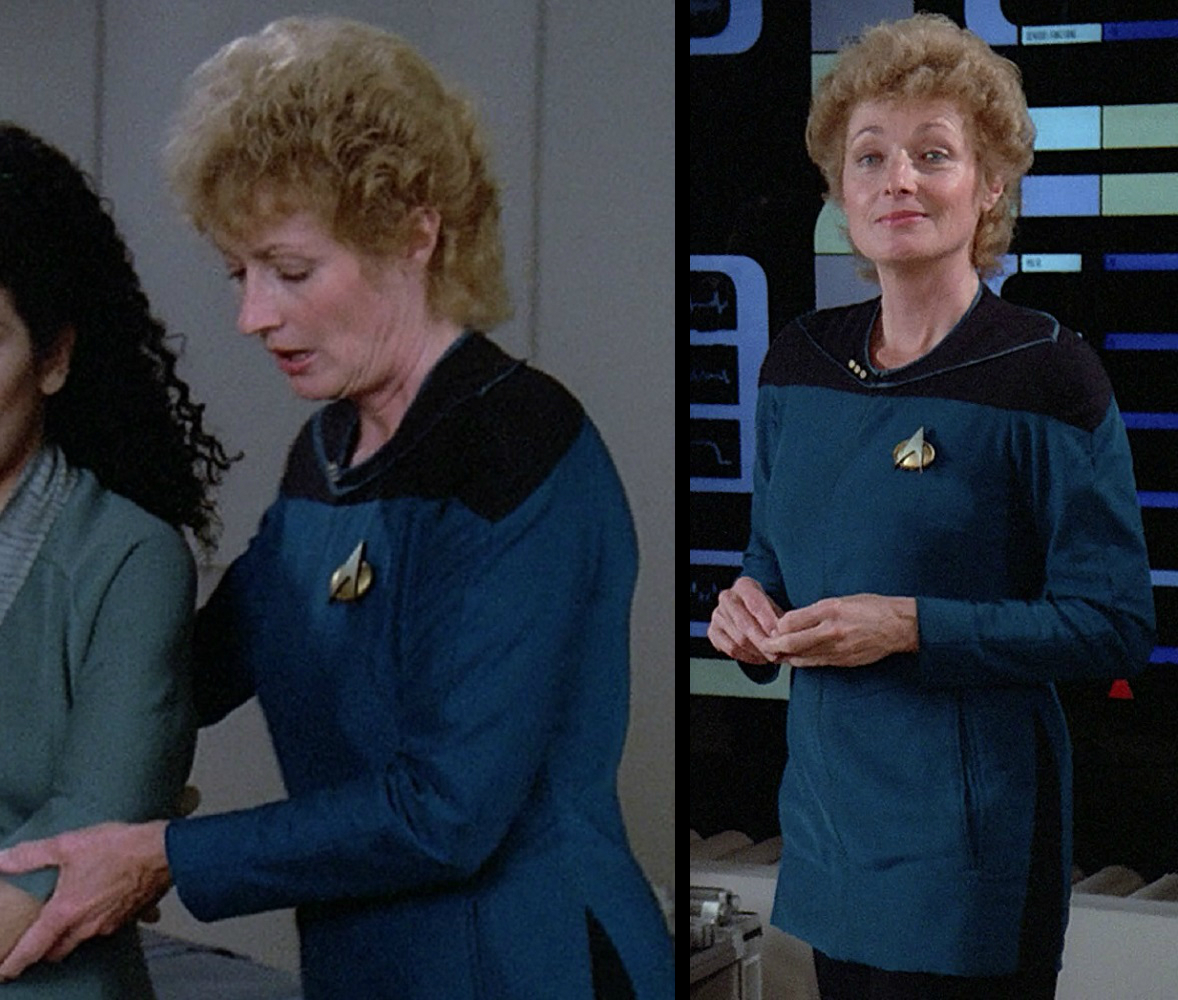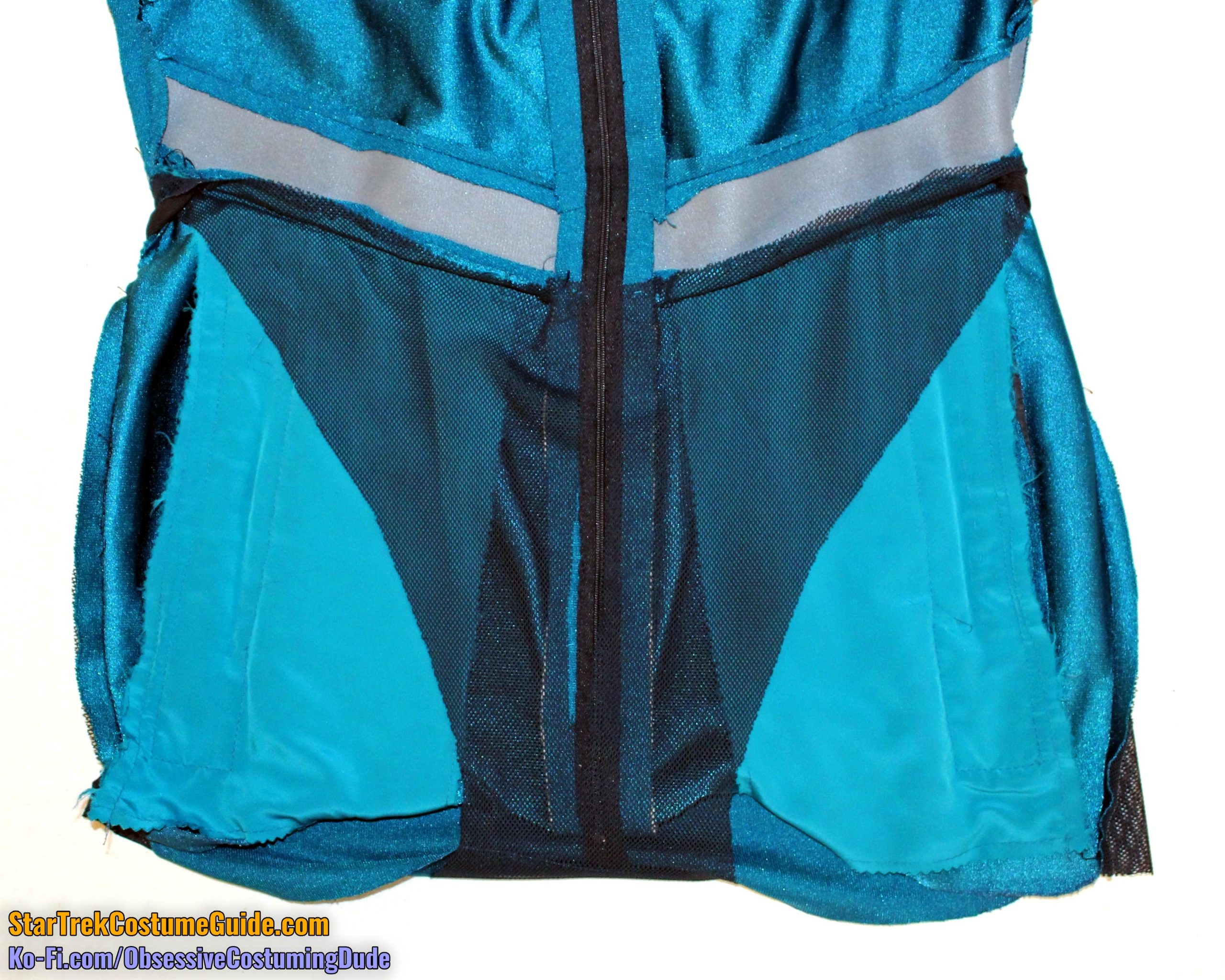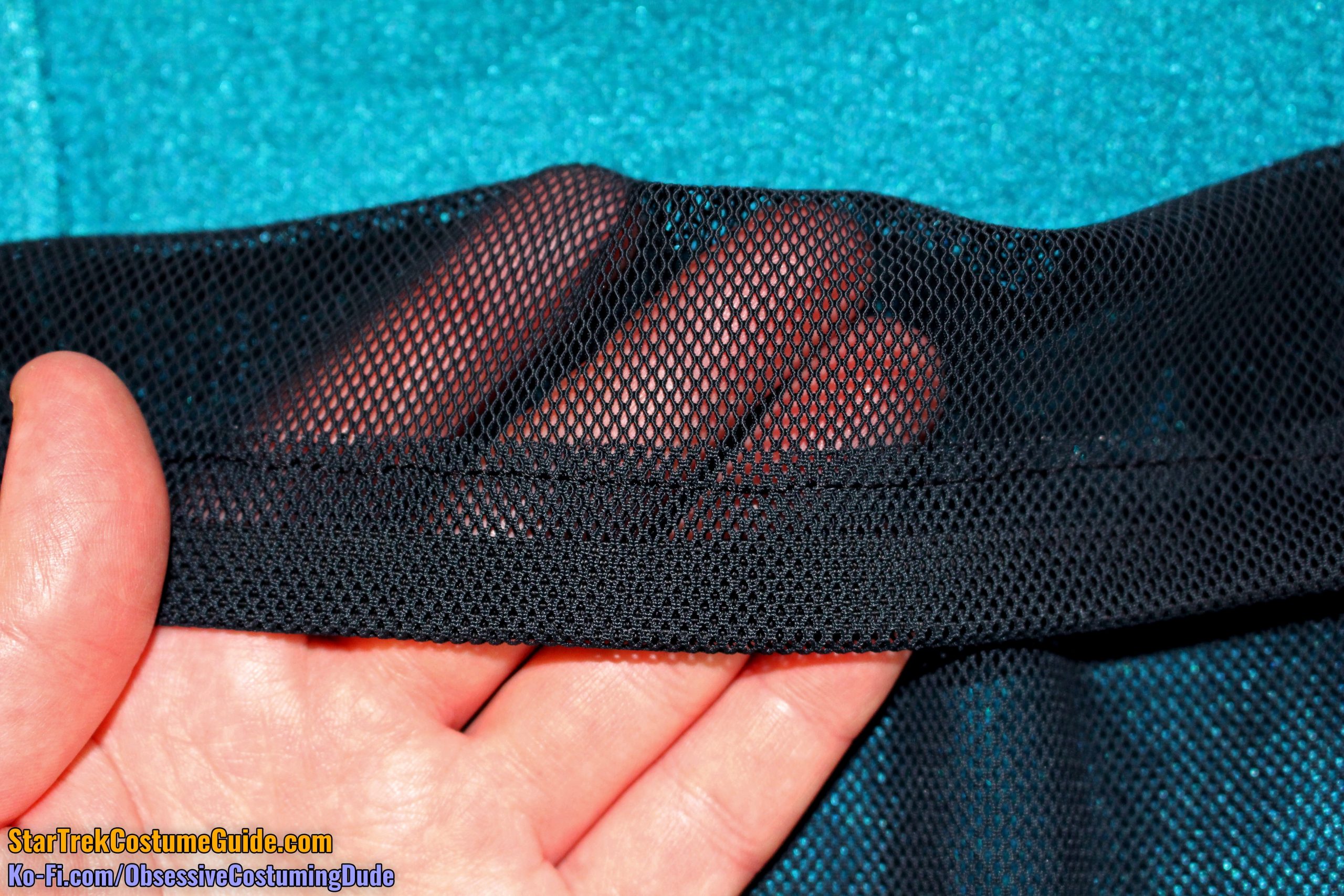Fabric
The first version of the TNG medical smock, Dr. Pulaski only wore during the very first episode of The Next Generation‘s second season, and it was perhaps the most unique variant she wore that production year.
Like its counterpart, the TNG jumpsuit, and its indirect predecessor, the TNG skant, this first smock was made of jumbo spandex (except for the neckline/yoke piping).
Observe that on the yoke, front body, and sleeves, the jumbo spandex was cut with the fabric stretch oriented vertically (up and down), rather than horizontally (around the wearer’s body), with the “weave” of the spandex flowing horizontally across the garment.
However, the back of the smock body was cut with the jumbo spandex oriented in the opposite direction, allowing the garment to actually stretch (somewhat) around the wearer.
Also observe that the “wrong” side (i.e. the dull/matte side) of the jumbo spandex was used as the “right” side, with the shiny side of the fabric serving as the underside.
Neckline and Yoke
The neckline on this first TNG medical smock wasn’t quite as wide as its TNG jumpsuit counterpart’s, nor did it have the characteristic V-shape of that or the TNG skant (although it did dip fairly low in the center front).
The neckline on the screen-used Dr. Pulaski uniform I examined was about 5” at its widest – about where the shoulder seams were.
The TNG medical smock’s upper structure was otherwise generally analogous to that of the early TNG jumpsuit’s, and the TNG skant’s.
Both the neckline and yoke were embellished with division-colored piping.
This “piping” was a thin strip of lightweight spandex, bias-cut, and simply folded in half without any cording (rounded or otherwise).
On all of the early TNG uniforms I’ve examined, the lightweight spandex used for the piping was a close, but not exact color match to the division-color jumbo spandex used for the uniform body.
Observe how the piping fabric occasionally responded differently to the lighting than the rest of the uniform.
Here, you can see the slight color/sheen differences between the jumbo spandex and lightweight spandex used for the neckline/yoke trim.
At a glance, the neckline trim appeared to have been constructed in the same manner as the other early TNG-era uniforms, but it actually wasn’t!
On all the screen-used Theiss TNG uniforms I’ve examined, the neckline trim was a strip of bias-cut fabric folded in half, sewn to the neckline, and turned under.
However, the neckline trim on this Dr. Pulaski uniform was actually attached more like typical bias binding; one layer of the trim was sewn to the neckline, pressed over, turned under, and a “stitch-in-the-ditch” secured the underside.
Here, you can just barely see the “stitch-in-the-ditch” on the outer edge of the neckline trim:
This construction method produces a subtly different result; rather than the neckline trim extending out from underneath the yoke, the trim actually sits on top of the neckline, creating a tiny “bulge.”
(And as you may recall, I believe Wood also favored this neckline trim technique on the TNG jumpsuits that season.)
The neckline trim’s allowance on the underside was ⅜”, and it was catch-stitched to the underside of the yoke.
As typical on the early TNG-era uniforms Theiss originally established, the neckline trim on the screen-used Dr. Pulaski uniform I examined was 3/16” wide, although it did occasionally widen to about ¼”.
The yoke piping was sewn into the yoke; both the front and back yokes were actually in two pieces (upper front yoke, lower front yoke, upper back yoke, and lower back yoke), with the seam establishing the contour of the piping.
The yoke/piping seam allowances were pressed upward.
Curiously, the yoke piping seam allowance was only trimmed down to about ¼”.
Although interestingly, on the screen-used Dr. Pulaski uniform I examined, there was very little curve to the yoke piping, on either the front or the back.
The gentle curve toward the shoulder appears to have been naturally achieved by the drape of the garment on the wearer.
At the center front, the yoke was about 1 ⅛” deep (including the neckline trim).
Of course, the front and back yoke piping properly aligned at the shoulder seams.
Unique Details
There were five characteristics which were unique to this version of the TNG medical smock.
As on the TNG jumpsuits, there were bust darts on this version of the TNG medical smock, and they were likewise angled upward toward center.
These bust darts were 1” tall and pressed open/flat over the dart’s stitch line.
I believe costume designer Durinda Rice Wood may have been inspired by Counselor Troi’s jumpsuits from the previous season, which had similarly-styled accents.
This waistband was 2” tall and made from the same jumbo spandex as the rest of the body, but it was patterned and cut separately, then incorporated into the body assembly.
The underside of the waistband was also stabilized with a white, knit fusible interfacing.
Third, there was tall, prominent slit along each lower side, beginning slightly below the waist and widening toward the lower edge of the smock.
Although it looked like a simple opening in the sides of the smock, revealing the black trousers underneath, there was actually a triangular, black mesh panel inserted into the lower sides.
Fourth, this version of the TNG medical smock had two back fitting darts – one on each side.
These darts were taken in a little over ½” each (total), at their widest points.
Considering this particular Pulaski uniform was only ever seen in a single episode (and the first episode of the season, at that), I wonder if costume designer Durinda Rice Wood was only informed about the “no pockets policy” after it was too late to do anything about it.
The pockets themselves were both 7 ½” tall, and the pocket was also edge-stitched around its perimeter.
The pockets were literally sewn closed by hand, making them purely decorative.
However, I was surprised to discover pocket bags on the interior of the costume – implying that these pockets may have originally been intended to be functional.
I believe they were, but they wound up not being viable for actual use – probably due to lack of stability, resulting from the spandex itself and/or only two sides of the pocket actually being fastened down.
(Something lightweight like a credit card wouldn’t be an issue, but a larger prop like a tricorder would result in an unsightly bulge, and putting one’s hands inside the pockets might risk pulling the smock out of shape.)
So, the lesson learned and decision made, the pockets were quickly hand-sewn closed – perhaps even on the day, between filming takes.
But that’s just my theory and interpretation of the screen-used Dr. Pulaski smock I examined. 🙂
Length
Like its indirect predecessor, the TNG skant, this medical smock appeared to be approximately knuckle-length.
The screen-used Dr. Pulaski medical smock I examined was 23 ⅝” long at the center front, measured from the bottom of the yoke to the bottom of the smock.
I find this curious, since this is over 5” shorter than the screen-used TNG skant I examined (which was 29” long, measured in the same manner) … yet Dr. Pulaski’s smock appeared to be about the same relative length as the TNG skants – or if anything, perhaps even a bit longer!
This could be a height issue, but there’s some confusion there, as Google says Marina Sirtis is 5’ 5” tall, while IMDB says she’s only 5’ 3”.
On the other hand, Google says Diana Muldaur is 5’ 5”, while IMDB says she’s 5’ 5 ½”.
Perhaps Diana Muldaur simply has short arms?
In any event, the back body panel was a couple inches longer than the front – 25 ⅝”, measured from the bottom of the yoke to the bottom of the smock.
Front Closure
The smock closed up the center front via a non-separating invisible zipper, with the uppermost 1” or so left hanging free and a trio of hook-and-eye closures at the top.
The total zipper length was approximately 23 ½”, and the bottom was simply sewn closed beneath the zipper.
The center front seam allowance was a full inch on each side.
Armscye and Sleeves
Like the other early TNG-era uniforms, the medical smock’s “silhouette” was gently rounded over the shoulders.
There were no shoulder pads included with the costume, but I believe this costume was intended to be worn with them – probably the same style as those on the screen-used TNG skant I examined.
There were two black snaps hand-sewn to the shoulder seam allowances, indicating removable shoulder pads.
The sleeves on Dr. Pulaski’s uniform were noticeably looser than those on the TNG jumpsuits.
The sleeve hem allowance was pressed upward and hemmed via catch-stitching.
Interior
And finally, there was a black mesh “panty” attached to the lower interior of the smock, made of the same black mesh as the side panel inserts.
This “panty” was almost certainly intended to “anchor” the smock into place on the wearer, preventing it from twisting or pulling upward.
Both the front and back were cut as a single piece, and it was attached to the smock along the front waistband’s lower seam allowances and the side seam allowances at the waist.
The upper back edge of the “panty” was hemmed with approximately 1” hem allowance and stitched down ¼” from the edge, creating a channel for a length of ½” black elastic.

